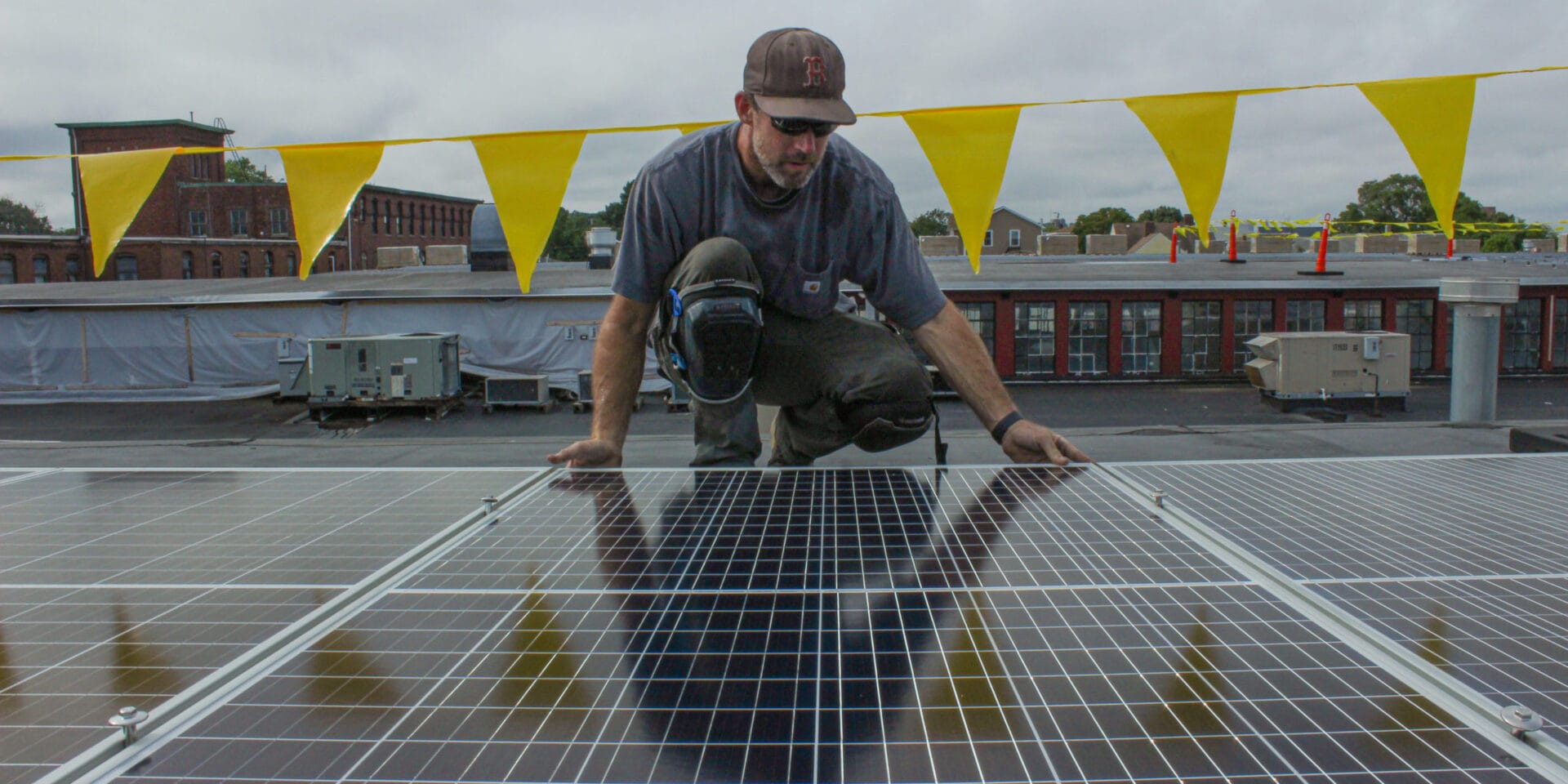
Solar News Stream of Conciousness
EV owners lowering electricity pricing for everyone
We observe that over the last 11 years, EV drivers across the United States have contributed approximately $3.12 billion more than their associated costs, driving rates down for all customers. When we also include utility expenditures for EV programs, EV owners have contributed approximately $2.44 billion more in revenues than in costs. we assume the majority of EVs are charged at home and mostly in the early evening at the end of the workday

A key reason why revenues from EVs outweigh the costs is that EV customers — particularly those on TOU rates — tend to charge during off-peak hours By charging during off-peak hours, EVs impose minimal additional costs on the grid and help to utilize resources more efficiently report published in 2019 by Lawrence Berkeley National Laboratory, PG&E, and the Natural Resources Defense Council shows that shifting EV charging to off-peak hours could allow the grid to accommodate all homes having EVs without upgrading most parts of the distribution systemLink
Vertical solar panels for cow grazing in New Jersey agrivoltaic system
south-oriented system consists of 18 rows of 21 panels with a total output capacity of 170 kW
ZnShine 450 W bifacial solar modules with a bifaciality rating of 70%
Panel orientation was varied throughout the system, allowing for a determination of the optimum orientation
Power optimizers were installed so that the output of pairs of panels could be tracked, ensuring optimal energy generation and efficiency
two different row spacings and panel mounting heights were used in the experimental design
Researchers will plant a forage crop in April and will start grazing beef cattle in September
objective is to study the impacts of the agrivoltaic system on forage production and animal grazing, including any behavioral changes the animals may exhibit when grazing among the panels
racking system can ensure up to 120 cm of clearance from the ground and is able to endure a maximum wind speeds of 167 km/h
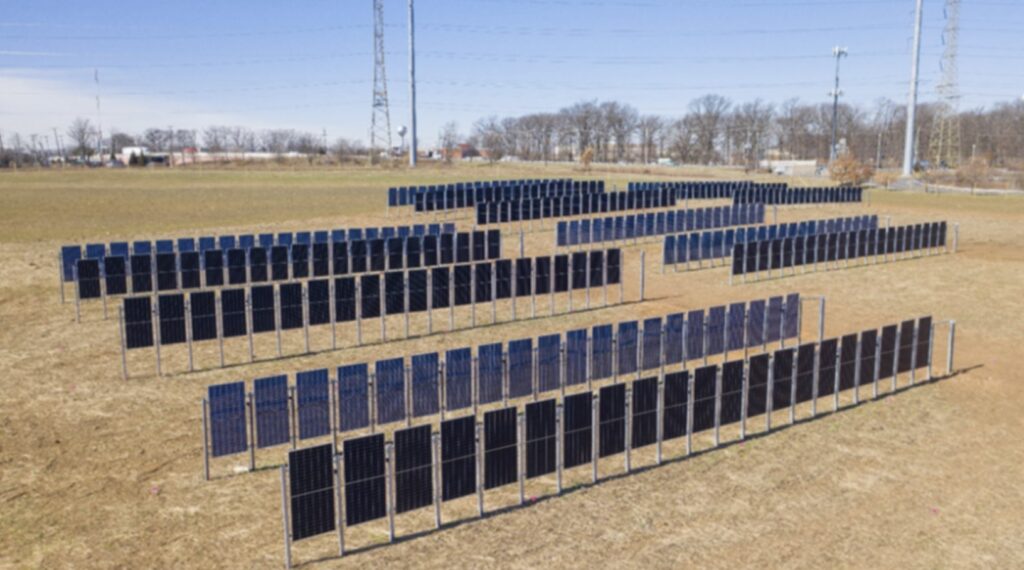
Energy precision coming – long lived and cheap battery released
The battery game is changing. In terms of pricing, it’s been happening since June 2023 – with cells more than halving, and it’s expected to go further.
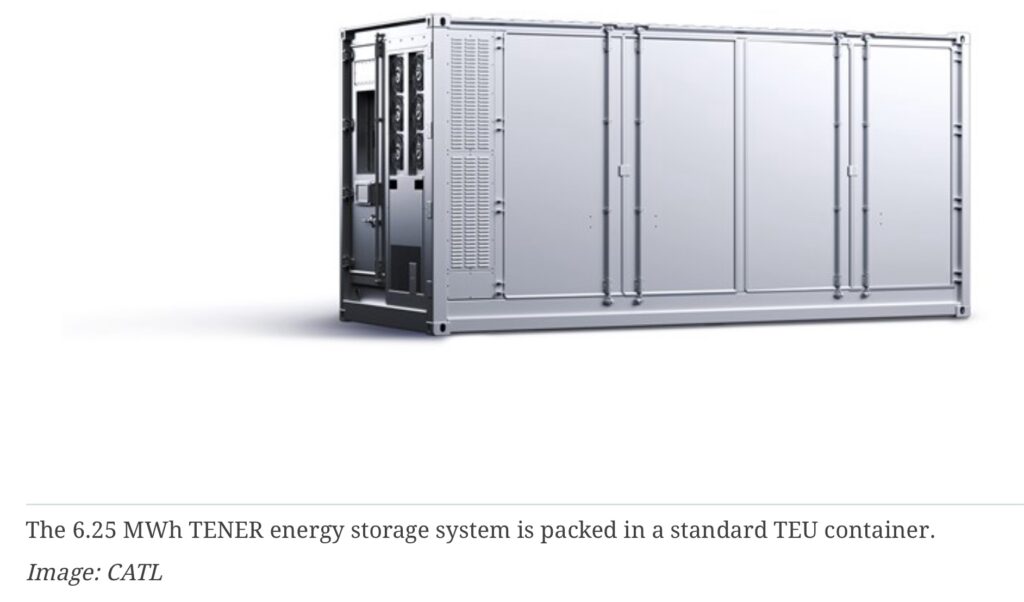
Now, a new high density grid energy storage format coupled with five years of no degradation may herald a new stage of deployment – batteries as a standard generation asset.
I’ve got visions of high frequency energy storage trading going on across the network of national storage assets, numbering in the hundreds of millions or billions. Electrons injected at the nearest location based on digitally dispersed demand delivered at the light speed.

Energy Precision.
Solar factory cancellations following manufacturing sprint
At least 16 photovoltaic firms listed on the mainland have canceled or delayed over CNY60 billion (USD8.3 billion) of investment projects since the fourth quarter of last year, according to data gathered by Yicai
Chen estimated that only five to six of the existing 10 industry leaders would stay after the ongoing industry reshuffle
Lingda Group, a developer of thermal power generation systems, recently scrapped an investment scheme of CNY9.2 billion (USD1.3 billion) after making big noise about venturing into solar power
LONGi optimized its structure and downsized due to falling prices
Former employees said that the firm may have laid off about 30 percent of its staff. On April 7, the company responded that the adjustment involved 5 percent of its headcount.
In the past 18 months, companies added more capacity than in the past 18 years.
China’s production capacity of silicon materials, silicon wafers, and modules will each exceed 1,000 gigawatts by this year, according to PV InfoLink
50% less silver, 33% less silicon – HJT solar cells getting better
Risen replaced its 150 µm wafer with a much thinner and flexible 100 µm wafer for its Hyper-ion HJT cell
By October 2023, its busbarless 100 µm Hyper-ion HJT Cell realized a 25.8% average production efficiency
Adoption of 50% low silver content metallization paste reduces metallization cost to 1.02 c/W
JT, the 2 key factors for Risen to invest in HJT are low LCOE and low carbon footprint
processing costs for HJT are a real concern as the technology requires a higher amount of silver paste, while TCO is a completely new material compared to PERC and TOPCon
after reducing wafer thickness from 150 µm to 100 µm, the same optical absorbance level was observed up to 700 nm light wavelength

negative impact of wafer thinning to 100 µm or even slightly lower is negligible.
during the test, the 150 µm PERC cell started to crack when deformation reached 46.74 mm, followed by the 130 µm TOPCon cell at 53.68 mm deformation
the HJT cell with thickness did not crack at the maximum point of load test at deformation, ensuring mechanical stability
production data showing the yield with ultra-thin wafers reached 99.2% and the breakage rate reduced to 0.2%
silver-coated copper paste with 50% silver content to reduce silver consumption
reduced metallization costs to 1.02 c/W
expecting to reach 0.64 c/W this year
plans to cut the silver content further to close to 40% this year to reduce the usage of silver from 10 mg/W to 7 mg/W, corresponding to 50% and 40% silver content, respectively
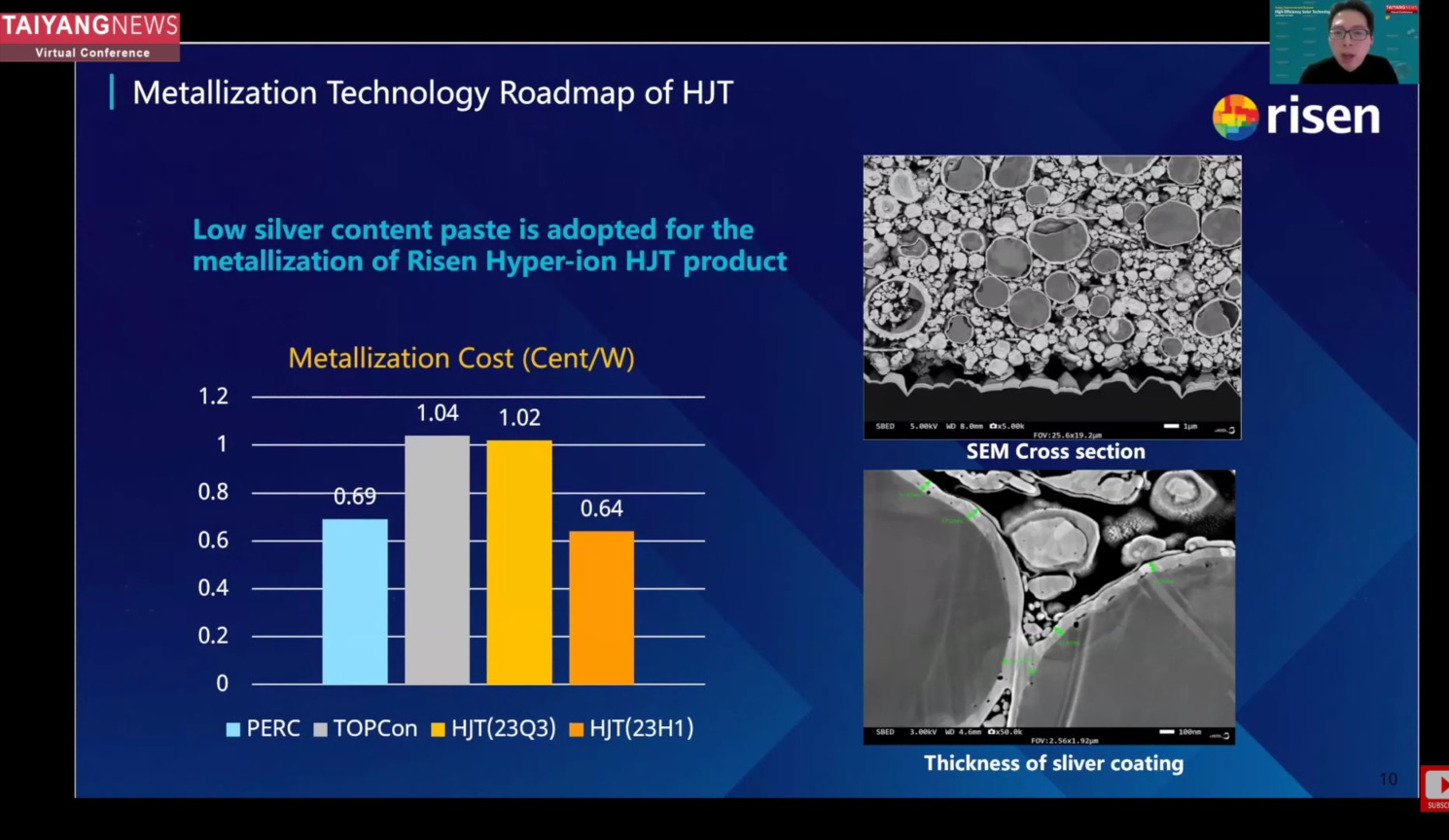
Cheap, new batteries putting pressure on used market
“A lot of people are dropping out of the second life energy storage space,”
24,000 sqm, c.US$30 million investment facility will produce BESS units for the residential and commercial and industrial (C&I) sectors using “new obsolete electric vehicle batteries”
most second life systems use batteries which were destined for EVs but never made it onto the road, for manufacturing or warranty reasons
C&I units, of between 82kWh to 1,288kWh, will only use new electric vehicle batteries from German premium vehicle manufacturers
Battery pricing collapse changing rules though
price falls led one company, Finland-based Cactos, to tell us in January 2024 that using new batteries was now more economical than repurposing EV batteries
Germany-headquartered Stabl’s CEO Dr Nam Truong said its systems cost €400-600 per kWh, several times higher than what ‘first life’ BESS cost now thanks to rapid price falls
One second life energy storage source, based in North America, told us recyclers would typically pay US$8 per kWh for batteries while a second life firm would pay around US$30 per kWh

How cheap could second life batteries get if new cells are super cheap already?
Street light EV charging, one hour installation
lamppost EV charger is now commercially available in major US metro areas
retrofits lampposts into a modular and upgradable Level 2 EV charging platform powered by a mobile app
Voltpost participated in the New York City Department of Transportation (DOT) Studio program, a collaboration between the NYC DOT and Newlab
Voltpost installed chargers on lampposts at Newlab in Brooklyn and in a DOT parking lot. The chargers were installed in an hour, operated with a high uptime, and got positive feedback from EV drivers.
lamppost EV chargers feature 20 feet of retractable cable and a charge plug with a pulsing light that routes the cable at a 90-degree angle to the car socket so the cable doesn’t become a hazard to pedestrians and traffic

can accommodate either two or four charging ports
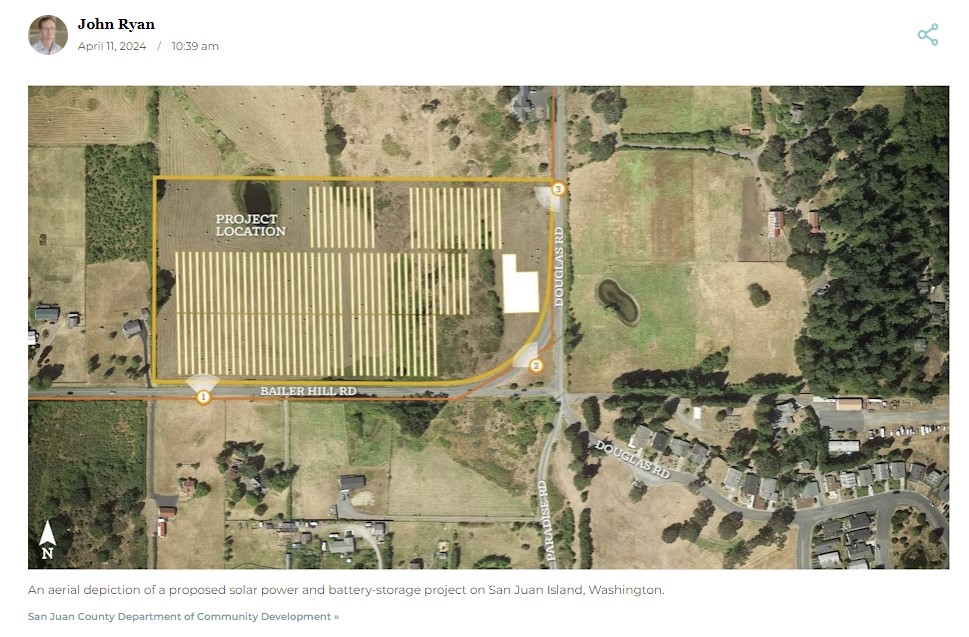
Island looking to add 2.5 MW solar, some locals upset
San Juan Islands, most power comes from the Washington state mainland, by way of two underwater cables
local electric utility wants to cover a pasture near the town of Friday Harbor with 5,200 solar panels
$13 million project would more than double San Juan County’s energy production
2.5-megawatt solar array would be big enough to power about 2,000 homes
sheep could still graze beneath the rows of solar panels, each panel swiveling on stilts to track the sun.

“We shouldn’t be using raw, undeveloped lands for solar arrays, especially natural areas, and prime agricultural lands,” Nielsen said. “I feel strongly that actually, we should be putting these solar arrays on buildings and over parking lots and places like that.”
It’s a cleared farming lot.
No more than 20% of any property within the island’s agricultural reserve, including the proposed solar-project property, can be converted to non-agricultural uses.
using just over 5.5% of the parcel for non-ag use
1,200 people already signing up to be eligible to purchase solar power from it.
looking to add a third power cable from the mainland.
Lawsuits alledges net metering for distributed solar undervalued, California
“By ignoring the acknowledged societal and other benefits of customer-sited renewable generation and assigning value solely to limited economic benefits, did the Commission fail to proceed in the manner required by section 2827.1(b)(3), which mandates that a net energy metering tariff must be ‘based on the costs and benefits of the renewable electrical generation facility?’
Essentially, the lawsuit is aiming to keep the spirit of the technique used to value rooftop solar, some sort of math based equation, but to change the input variables. For instance, it used to be that daytime electricity was the most expensive part of the day – solar ended that. In New England, it is estimated that rooftop solar installations save all electricity users billions via lower wholesale pricing.
All under one roof battery recycling facility opens in Oklahoma
Green Li-ion has launched a commercial-scale plant to process unsorted battery waste, or “black mass,” from used lithium-ion batteries
plant will produce sustainable, battery-grade cathode precursor, lithium, and anode materials – closing the EV recycling loop with the production done all in one plant
uses a novel and advanced hydrometallurgical approach that closes the recycling loop by directly converting recycling scrap into battery-grade precursor cathode active material (pCAM) without being exported for further processing
Green Li-ion says its process significantly reduces production time, yielding pCAM in around 12 hours
emits up to 90% fewer GHG emissions than virgin materials processing.
first in North America capable of processing unsorted black mass of different Li-ion battery chemistries into pCAM at commercial scale, ensuring 99% purity
expected to create 2 metric tons of pCAM at battery grade, or the equivalent of 72,000 smartphone batteries per day
44.3% efficiency potential for perovskite silicon solar cells
Perovskite-perovskite-silicon triple-junction solar cells have technical potential to reach 44.3% efficiency
optical properties of perovskite/perovskite/silicon triple-junction cells suggest 44.3%
roadmap includes the adaption of the perovskite absorber thicknesses, modifying bandgaps, employing a fully textured cell, and optimizing the thicknesses of the interlayers between the absorbers
researchers initially assumed the triple junction cell to be based on a bottom silicon heterojunction cell with an indium tin oxide (ITO) layer and a silver (Ag) metal contact, a middle perovskite cell with an energy bandgap of 1.57 eV, and a top perovskite cell with a bandgap of 1.84 eV

In the optimization process, their efforts were directed to increase the photocurrent of all three cells
varied the thicknesses of the three absorbers and then they adjusted the perovskites bandgaps. Moreover, they applied a textured front side to mitigate reflection losses and used thinner interlayers
simulation showed that the best cell configuration may potentially achieve a power conversion efficiency of 44.3%, an open-circuit voltage of 3480 mV, a short-circuit density of 14.1 mA cm−2, and a fill factor of 90.1%
Drones for solar use cases
For Marketers, the DJI Mavic Mini is a top choice.
For Surveyors, look at the DJI Air 2S or Autel EVO II V3.
For O&M use cases on residential and small commercial systems, consider the DJI Mavic 3 Enterprise or Autel EVO II Dual.
commercial drones also come in various shapes and sizes, with prices ranging from around $500 to well over $10,000
strong case for high-end drones like Parrot Anafi and Skydio as well
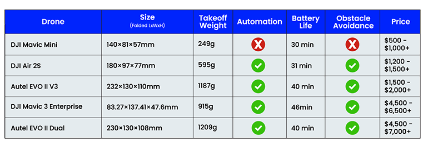
Printing solar like newspaper gets new efficiency record – 11%
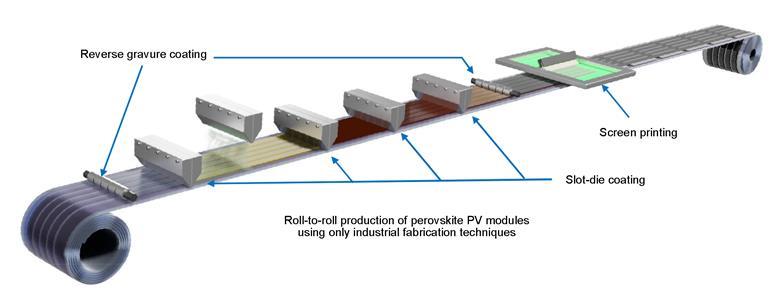
print perovskite solar cells could streamline the scale-up of the technology
Our team demonstrated the roll-to-roll production of series-connected [solar] modules for the first time and achieved a significant increase in the record efficiency of solution-processed solar cell
perovskite layers and other components are printed onto the substrate sequentially
main challenge is to ensure that each layer dries and settles completely before the next layer is deposited
printed all the interlayers, including the components for electron and hole transport and both the carbon and silver electrodes

roll-to-roll printed perovskite cells exhibit efficiencies of up to 15.5% for small-area [devices] and 11% for large-area modules
roll-to-roll printed perovskite cells exhibit efficiencies of up to 15.5% for small-area [devices] and 11% for large-area modules
With these parameters, the predicted cost could come in at 70 cents (55p) per watt
The printer:

90 GWh underground hot water cavern to keep Finnish city warm
total of three caverns about 20 meters wide, 300 meters long and 40 meters high will be excavated
bottom of the caverns will be 100 meters below ground level
underground caverns will be filled with hot water
Pressure will be created within the space, allowing the water to reach temperatures of up to 140 degrees without the water boiling or evaporating
total volume is 1,100,000 cubic meters, including process facilities
fully charged seasonal thermal energy storage is 90 gigawatt-hour, could heat a medium-sized Finnish city for as long as a year
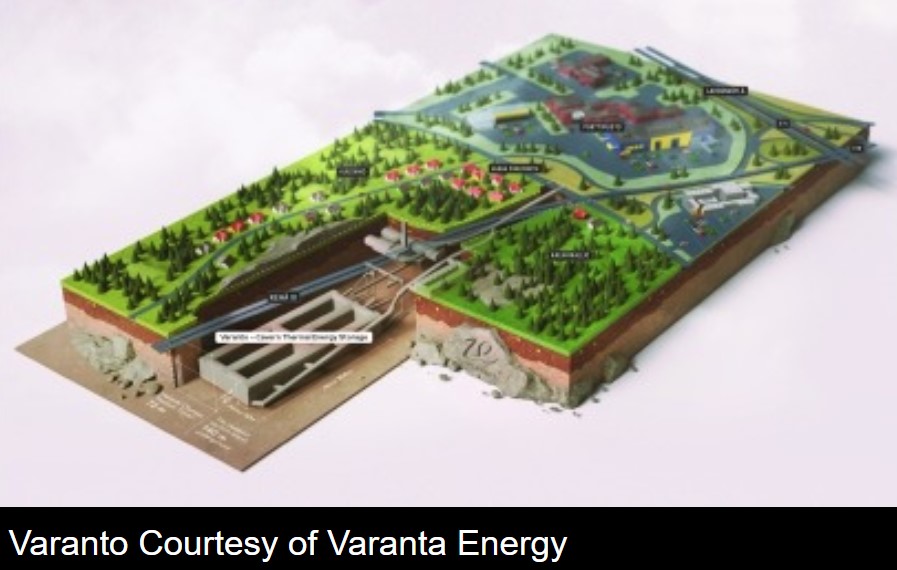
Two 60-MW electric boilers will be built in conjunction with Varanto. These boilers will be used to produce heat from renewable electricity when electricity is abundant and cheap
project cost is estimated to be around 200 million euros, and it has already been awarded a 19-million-euro investment grant from Finland’s Ministry of Economic Affairs and Employment. Construction of the storage facility
could be operational in 2028
3% variation in global wind power over 15 years
worldwide wind power production is very predictable, with annual variations remaining within a ± 3 % range
wind energy indexes that Eoltech releases each month for the 300 geographical areas worldwide with the highest number of farms
Global Index covers geographical areas which host about 80% of the world’s operating onshore wind farms as of 2023, while the European Index cover 97% of the continent’s operating wind farms
European Index shows that wind resource annual variations are within a ± 7% range in Europe, compared to ± 3% worldwide
Locally, the production of a wind farm can differ significantly from one year to another, up to 25%, due to the variation of the wind resource
our analysis does not show any downward trend over the last 15 years in the global wind resource
wind does always blow somewhere on the planet
Research suggests hydrogen storage in depleted methane and oil reservoirs possible
computer simulations and laboratory experiments to see if depleted oil and natural gas reservoirs can be used for storing this carbon-free fuel – Hydrogen
studying if hydrogen stored in depleted oil and gas reservoirs will get stuck in the rock, leak out, or get contaminated
found that hydrogen does not stay inside sandstone after it is pumped out, but up to 10% of the adsorbed gas got stuck inside the shale sample
Ho said, this is quite positive for underground storage of hydrogen
when the hydrogen is removed for use, it will contain a small amount of natural gas
not terrible because natural gas still has energy, but it contains carbon, so when this hydrogen is burned, it will produce a small amount of carbon dioxide
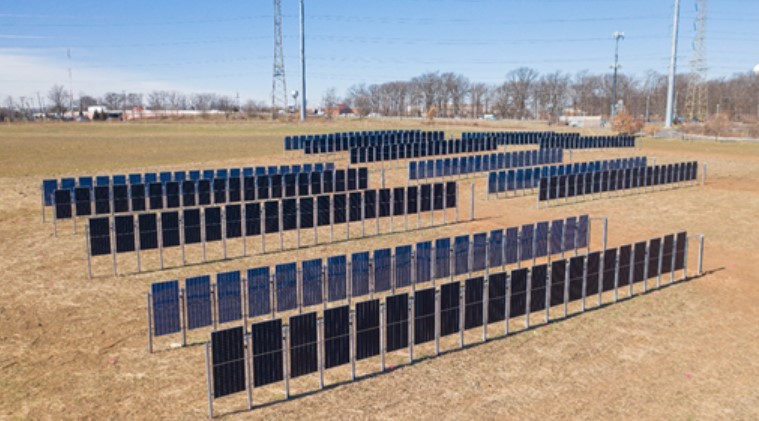
Vertical solar modules installed in New Jersey
total output capacity of 170 kWDC and consists of 18 rows of 21 ZnShine 450-W bifacial panels each mounted in rows running North to South
Peak electricity production occurs during the early morning and late afternoon hours when sunlight is received from the East and the West
farm at Rutgers University-New Brunswick operates as a hybrid of production farm, research facility and teaching operation in support of the Rutgers School of Environmental and Biological Sciences and Rutgers New Jersey Agricultural Experiment Station related activities
Nine electric buses for South Florida
Hallandale Beach proudly announces the acquisition of nine (9) cutting-edge electric buses
largest electric bus fleet owned by any municipality in Florida
total bill for the new bus fleet comes in at $5,906,828, paid for by a State of Florida Department of Transportation (FDOT) totaling $3,406,828 million along with a contribution of $2.5 million from the city, with $1,937,128 of that money (give or take) going towards the purchase of the Cloud electric buses and the installation of the necessary EV charging infrastructure
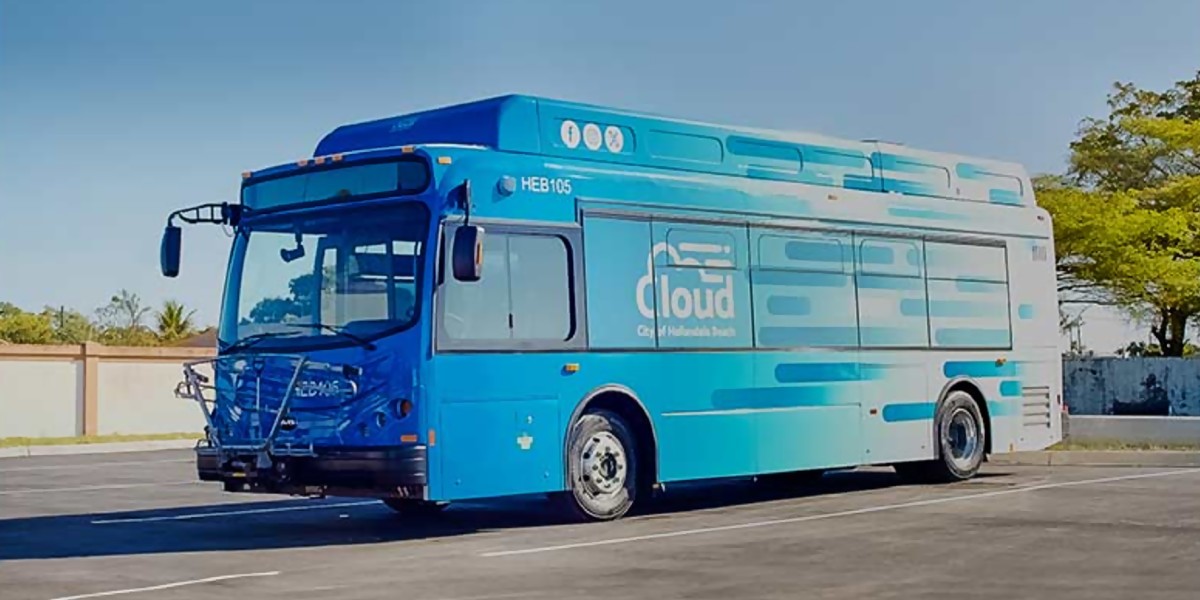
The bus seems to be the BYD K7M 30′ EV transit bus. The city lists the unit here. The unit seats 22+1, has a top speed of 56 mph, and a working range of up to 158 miles. It’s maximum power output is 90 kWx2, with a max torque of 400 N*mx2. The BYD blade LFP battery capacity is 215 kWh, with a charging capacity of 150 kW. It would take 2.5-3 hours to fully charge via AC charging, versus 1.5-2 hours via fast charging DC.
World’s most efficient solar panels as of April 2024 – sixteen models at 22.5% efficiency and above
in the highest efficiency band above 22.5%, only 2 companies, Maxeon and Jolywood, offered such products until June 2022
July 2022, Huasun joined the club with a 22.53% HJT module
Aiko made a remarkable entry in March 2023, directly taking the top spot with its 23.6% efficient ABC module series, and subsequently raising the bar again with a 24% product in June
by the end of 2023, a total of 9 products/companies reached the above-22.5% efficiency band
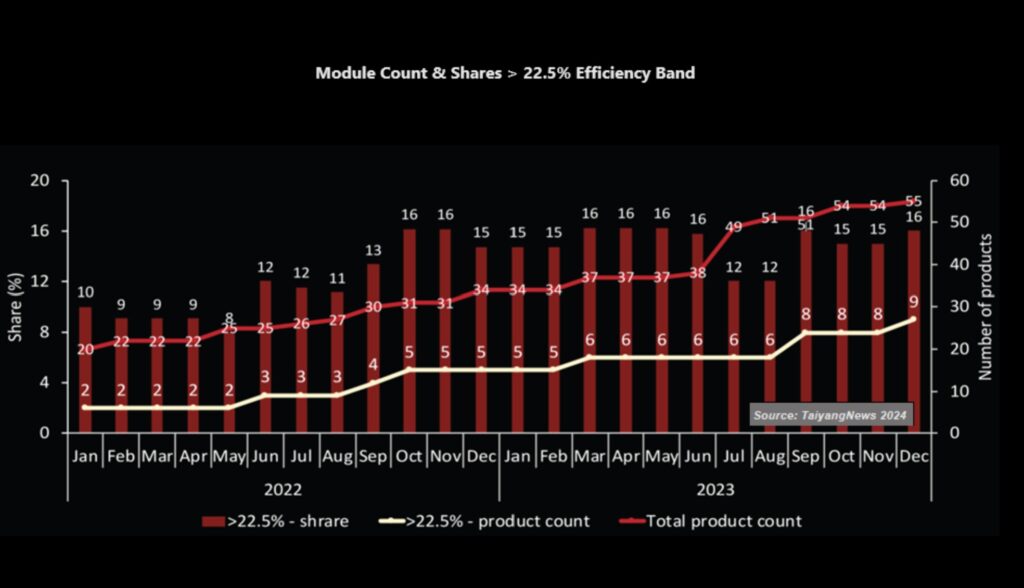
Battery noise is minimal, concerns likely being pushed by detractors
noise of battery energy storage system (BESS) technology has “exploded” as a concern in the last six months
“I’d say that in the last six months noise has exploded as a concern. One of our team just toured a dozen customers in Europe and every single one brought up concerns about noise, and what we are doing to mitigate it. A year ago, nobody asked”
Sungrow pointed out to Energy-Storage.news in a recent interview that its latest generation product increased the energy-per-container from 2.5MWh to 5MWh but the max noise emissions went from 79dB to 75dB.
An analysis done for a battery project in California showed tat the sound level at the property line, 450 feet from a battery, was 59.4 – which is in the upper range “quiet” to lower range of “moderate” noise.

India’s first ingot and wafer manufacturer
Adani Group has reportedly started producing ingots and wafers for its solar cell and module manufacturing plant, according to a report from Reuters
capacity of 2GW
will be used to make solar cells and modules in Adani’s module assembly plant in Gujarat, India
Adani Group also aims to produce polysilicon in 2027 at the earliest, becoming India’s first integrated solar manufacturer
Adani Solar claimed that it is India’s largest vertically integrated solar company with a manufacturing capacity of 4GW.
December 2022, the company’s solar PV manufacturing and research arm Adani Solar produced India’s “first” large-sized monocrystalline silicon ingot in the Mundra manufacturing plant
Used EVs under $25-30k increasing
number of used EVs sold in the U.S. grew from 283,000 in 2022 to just under 400,000 in 2023, and are expected to reach nearly 560,000 in 2024.
more than half of the used EVs available were under $30,000 as of February, up from around 40 percent in December
Almost 30% of all used EVs are $25,000 or less
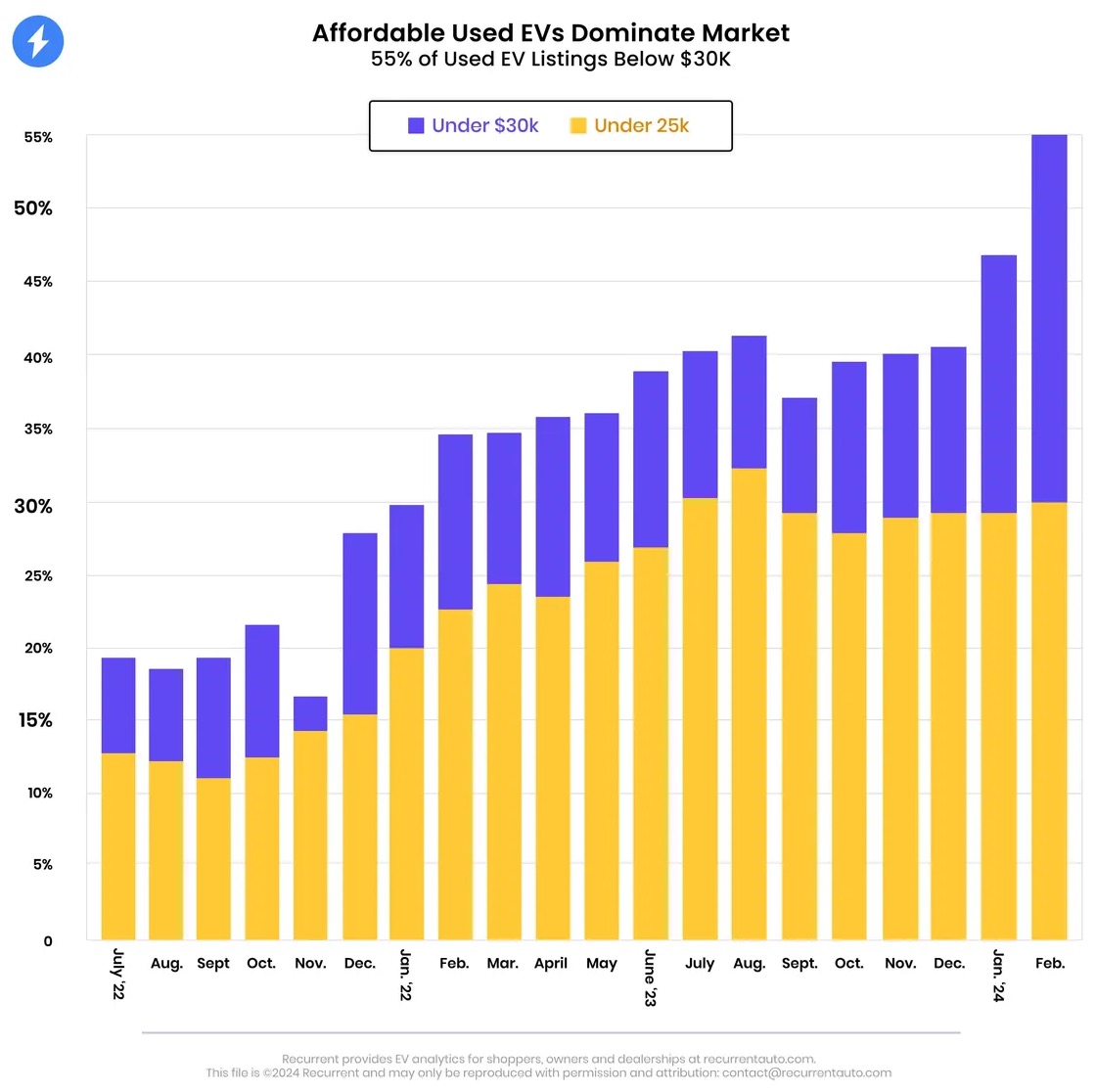
Because used Teslas compete with every other EV, that’s forced other used EV prices down
For qualifying used EVs, that (tax credit) value is up to 30 percent of the cost, with a cap of $4,000, only applies to vehicles that cost $25,000 or less
applying the $4,000 tax credit to a buyer’s down payment reduces the “loan-to-value ratio” that lenders consider when assessing the risk of making a loan

Parametric insurance customizes solar hail coverage by stone size
The report depicts a clear rising trend in the number of days of hail over 2″ in diameter each year — and last year was a particularly active one
In 2023, Louisiana saw 65% more days with 1″ hailstones compared to the 20-year trend, Tennessee 60%, Alabama 54% New Mexico 45%, and Texas at 42% more.
A GCube report from late last year confirms that the effect of these intersecting trends is already being felt: Hail is now responsible for more than half of all solar claims costs, despite constituting only a fraction of solar claims by volume
The average solar hail claim now comes to a whopping $58.4 million
In 2023, The New York Times reported, State Farm’s hail claims totaled over $6 billion — more than the previous two years combined.
benefit of a parametric policy is that it has “the ability to tailor coverage off very specifically designed and agreed-upon policy triggers — namely, hailstone size.”
Solar owners can thus determine what size of hailstone their panels can withstand, calculate the probability that future hail will exceed that size, conclude how much risk they want to retain, and then very precisely make up the difference between that retention and a general P&C policy
U.S. has good radar infrastructure; there are Doppler radars networked throughout the country, and we work with third-party data providers that accurately certify that data
“We’re able to look at, in quite granular views, the hail swath or the hail track of an event and see what hailstone sizes were falling, and we can see what area of the asset was impacted.”
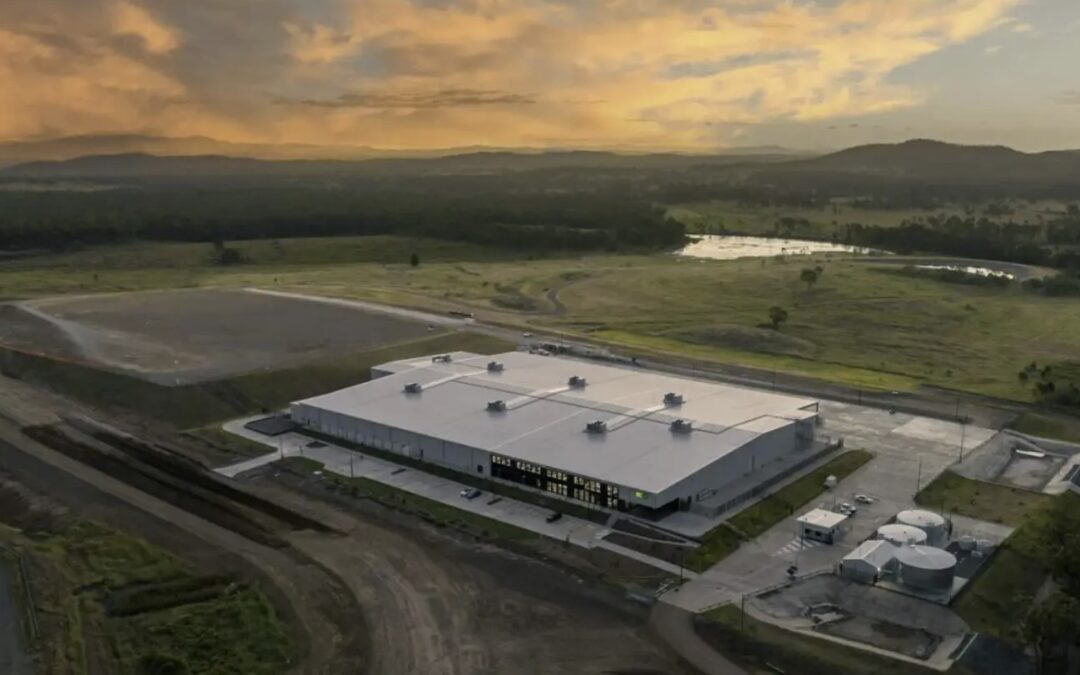
Hydrogen electrolyzer factory opens in Australia – 2 GW/yr
Fortescue Metals has officially opened its 2GW/yr hydrogen electrolyser factory in Gladstone, Queensland
first in the world to house an automated assembly line
Proton Exchange Membrane (PEM) electrolyser stacks that have been developed in-house by Fortescue teams in Australia and the US
also received approval to build a 50 MW green hydrogen production facility at the site.
ueensland government provided an electrical sub-station, a road network, communications and local scheme water connection, as well as land for the project
federal government also contributed AU$44m from the Collaboration Stream of the Modern Manufacturing Initiative
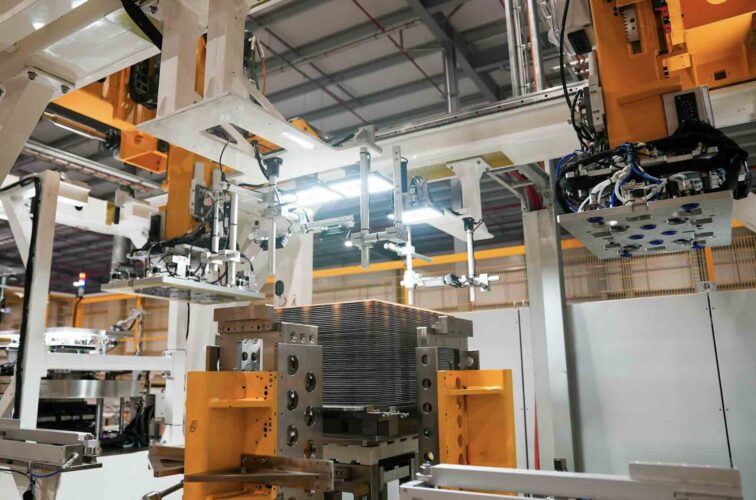
Australia’s largest “remote grid” solar plant for mine
99 MW DC/88 MW AC Dugald River Solar Farm (DRSF) is located in Mount Isa, Queensland
184,000 solar panels
contracted to supply power to mining group MMG, Mount Isa Mines (MIM) and New Century, firmed up by gas from APA’s Diamantina Power Station located nearby
providing its Dugald River Mine with around 1/3rd of its electricity needs and helping it reduce its carbon footprint
firmed by nearby gas plant
32-year lease with the Queensland government for the project site
Coal Governor kills solar bill
Governor Justice vetoed House Bill 5528, aiming to increase utility-scale solar project capacity in West Virginia, citing potential harm to the coal industry
“Really and truly, I believe that what is going on from the higher-ups that are incentivized to try and shove coal to the background”
“it is very important that we are careful not to cripple our great coal-fired energy industry in the process”
House Bill 5528 would have lifted the limit on utility-scale solar project size from 50 MW to 100 MW.
coal-fired electric power plants accounted for 89% of West Virginia’s total electricity net generation, according to the U.S. Energy Information Administration. Hydroelectric power and wind energy contributed 7%, and natural gas provided about 4%
0.08% of all electricity in the state comes from solar power
Off the pace – 7.2 TW of new renewables needed by 2030
will require annual additions to grow from 473 GW in 2023 to over 1.1 TW annually between 2024 and 2030
Annual investments too must increase from $570 billion in 2023 to $1,550 billion on an average between 2024 and 2030 to achieve an additional 7.2 TW renewable additions.
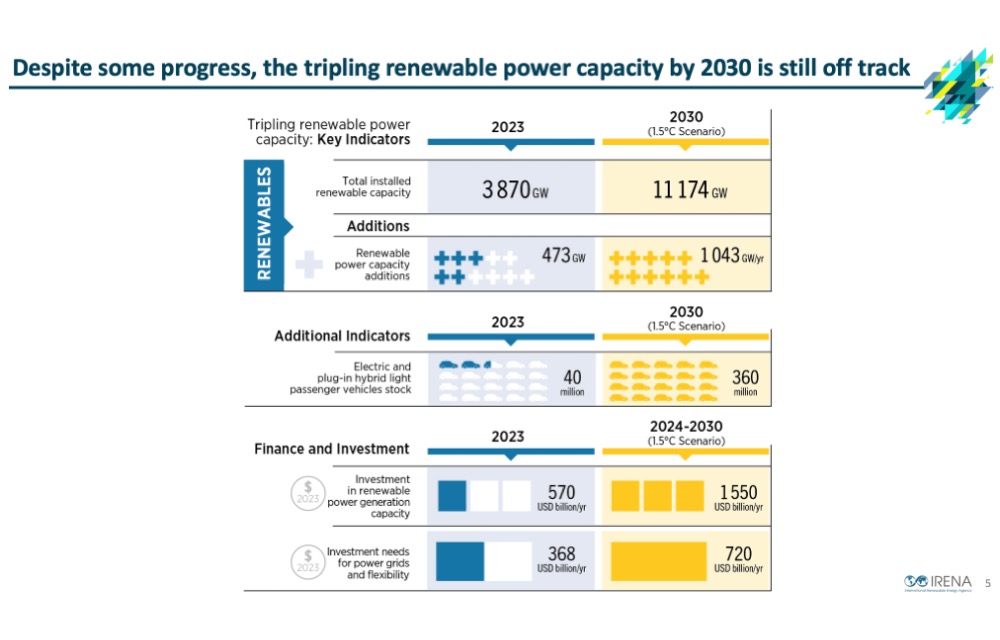
Green polysilicon “mine to manufacturing ” solar powered project approved in Australia
plans to source high-quality silica quartz for the polysilicon fab from the North Queensland quartz and silicon mining project proposed by Solquartz
AUD 7.8 billion ($5.1 billion) Project Green Poly
country’s 1st integrated mine-to-manufacturing polysilicon supply chains,
factory is proposed to be powered by a large-scale solar and storage project
expects to create around 4,400 local jobs during construction and operation period of the facility. It will have a functional life of 30 years or more.
Fossil free 1.2 GW/yr solar panel plant developing in Sweden
1.2 GW annual capacity, it will be equipped to roll out over 2.5 million solar panels/year
GIGA ONE is the 1st factory for Nordcell that aims to build a vertically integrated production covering all 4 primary stages of solar panel production, namely silicon, ingot and wafer, cells and panels.
green-energy powered solar panels at its artificial intelligence (AI)- driven automation and state-of-the-art fab will be of high quality and competitively priced
1,300 mile solid state EV battery invented
prototype cells house an energy density of 720 Wh/kg – more than double other cells currently being integrated into passenger EVs in China
improves the migration ability of charged particles inside the cathode by building an efficient ion and electron transmission network, and uses self-developed interface flexible layer materials to effectively reduce the interface impedance while also improving the interface stability
120 Ah solid-state battery cell
breakthroughs pertain specifically to ultra-thin and dense composite oxide solid electrolytes, high-capacity advanced positive and negative electrode materials, and an integrated molding process
could offer over 1,300 mile range

‘Lamborghini Mini’ EV may be UK’s cheapest car
BYD’s most affordable Seagull EV, starting $9,700 (69,800 yuan)
30.08 kWh and 38.88 kWh Blade Battery options, good for 190 mi (305 km) and 252 mi (405 km) CLTC range
launched the new Seagull in China with three trims: Active, Free, and Flying, priced between 69,800 yuan ($9,700) and 85,800 yuan ($12,000).
base Seagull model features a 190 mi (305 km) CLTC range, a 10.1″ rotating center screen, DiLink intelligent connection
nickname “Lamborghini Mini,” local reports claim, as former Lamborghini designer Wolfgang Egger led the EV’s design
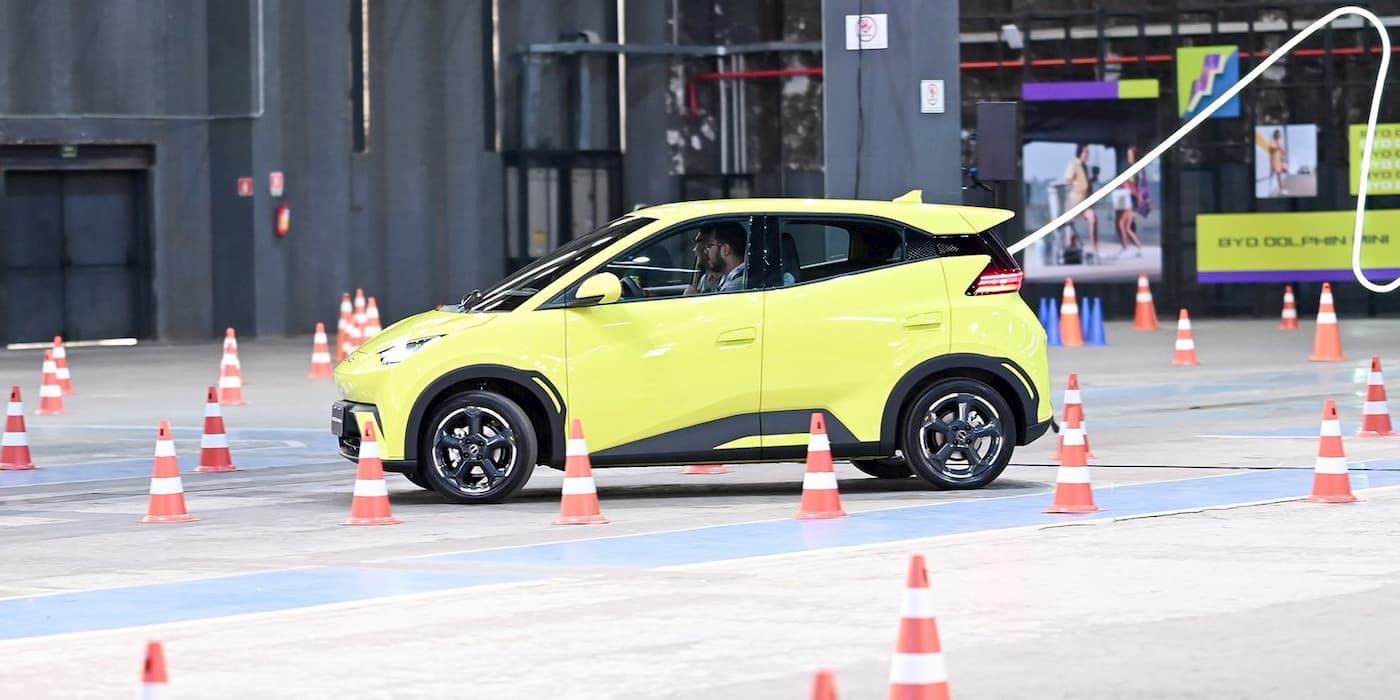
Big California battery incrementally powering up – 680 MW/2720 MWh(?)
510MW phase one of the Nova Power Bank will be complete this summer, with another 110MW coming online in autumn and the final 60MW in 2025
43-acre project is on the former site of Calpine’s Inland Empire legacy power plant, which it decommissioned in late 2022
didn’t reveal the capacity of the project but said that it could power 680,000 homes for four hours, implying it has a 4-hour duration, as the vast majority of California projects do. That would make it 2,720MWh
slightly smaller than the two largest operational BESS projects in the world, Moss Landing (3,000MWh) and Edwards & Sanborn (3,272MWh)
BYD battery units
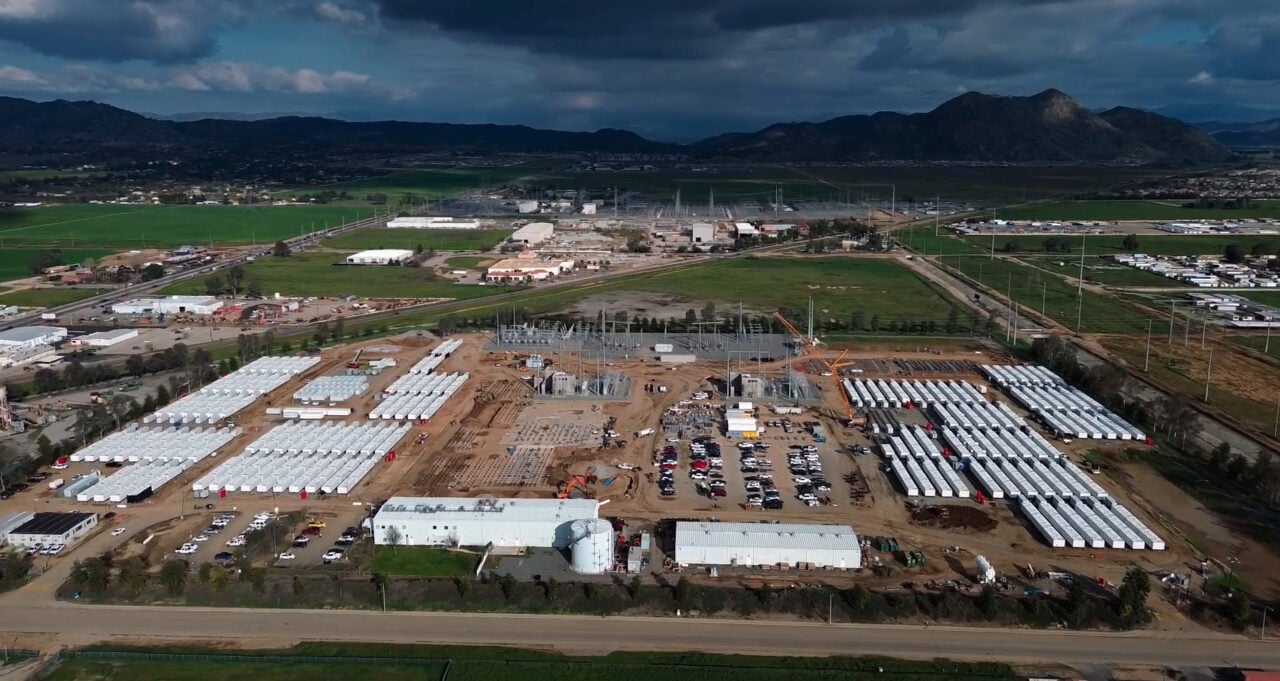
An aerial view of the site currently, showing the majority of BESS containers in place. Image: Calpine Corporation.
Quinbrook’s $600 million acquires 51% of 2.65 GW solar plus storage
successful closing of Quinbrook Valley of Fire Fund with $600 million in capital commitments from leading US and European institutional investors
acquires 51% stake in landmark Gemini Solar+Storage Project and Valley of Fire development portfolio
690 MWac of solar + a 1,416 MWh battery storage facility, Gemini
Valley of Fire portfolio is made up of seven projects totaling over 2.65GW of solar PV capacity with the potential to add a further 1.5GW of battery storage capacity
PJT Partners LP acted as the lead financial advisor on the transaction. Kirkland & Ellis LLP served as legal counsel to Quinbrook, while Proskauer Rose LLP served as legal counsel to Blackstone Strategic Partners.
The lead investor in the Quinbrook Valley of Fire Fund is Blackstone Strategic Partners.
cornerstone investor Ares Management Infrastructure Secondaries funds
Meyer Burger raises $228 million
solar manufacturer Meyer Burger has raised CHF206.75 million (US$228 million) following the closure of its rights offering
funds, which were provided through the issuance of 20,144,423,886 new shares, will go towards Meyer Burger’s US expansion, where it is building a 2GW module production facility in Arizona and a 2GW cell manufacturing plant in Colorado Springs
97.54% of the available shares were taken up through subscription rights offered to existing shareholders
company’s largest shareholder, Sentis Capital, purchased 3.276 million shares at CHF32.7 million (US$36 million). This represented all of its subscription rights and an additional 1.186 million offered shares.
Tandem cell types, 4T looking strong, show their strengths – still six years out
study is unique in the range of tandem technologies assessed, including two-terminal (2T), three-terminal (3T) devices, and two types of four-terminal (4T) tandem devices, stacked 4T and spectral splitting 4T, although the latter is not discussed in-depth
For each category of tandem solar cell, the team looks at the technology at the cell level, scaling level, cell-to-module, manufacturing, reliability, costs, environmental impact topics, and commercialization risks, with a focus on challenges and opportunities
technical challenges as well as business-centered challenges
benefits and drawbacks to all architectures
4T configurations have the potential to leverage the ability to manufacture top and bottom junctions separately, giving it design and process flexibility advantages
given the amount of effort going into 2T architectures, they may also reach the market on a similar timeline
researchers provide a list of twelve physical and economic needs to be addressed if the technology is to reach 2% of market share by 2030
we are optimistic that the next 6 years will yield significant advances toward tandem commercialization
Russians bomb Ukrainian solar
On 3 April, Russian forces targeted a Ukrainian solar power plant for the first time.
not an attack within the combat zone, but rather a strike on a facility located deep within the country

Colorado locals watching as state considers solar permit reform
state could move to potentially eliminate setback standards and restrict local governments from passing certain ordinances, which would prohibit local control to pass temporary moratoriums on new utility projects to give local governments time to review and update codes
San Miguel County currently has a moratorium in place on new utility projects as it works to update its regulations and garner public input.
really does beg the question to me of what problem are we solving here by trying to have some state overreach into this area,” Flenniken said, “when counties, cities and other local governments are working to find codes that make sense for their communities that are reflective of their values
China’s largest battery integrator focusing on US market
largest BESS system integrator in China, targeting the US energy storage market
Beijing HyperStrong Technology
largest system integrator in China, it claims, and one of the top five in the world by deployments according to S&P Global
Last year it deployed 10GWh in China and this year expects to do 20GWh
integrator definition:
Hyperstrong buys battery cells and integrates them into a range of BESS solutions including DC and AC blocks along and building its own BESS components like containers, inverters and an energy management system (EMS) platform
firm’s latest generation BESS solution is a 5MWh 20-foot DC block offering 1-4 hour durations, and it claims 10GWh of orders from outside China already
Million mile electric vehicle battery for sale
new electric vehicle battery pack with a 1.5 million kilometre (932,057), 15 year warranty
will be using the long life battery packs in their buses and heavy vehicles. Yutong, one of China’s largest bus manufacturers
lithium iron phosphate (LFP) battery will be able to cater to different market segments, including buses, light trucks and heavy trucks
long-life battery will also have zero degradation in the first 1,000 cycles
battery with 500 km (310 m) of range would have zero capacity degradation for the first half million kilometres
541 REAP grant projects take $120 million
541 projects are being funded by the Inflation Reduction Act through the Rural Energy for America Program
U.S. Department of Agriculture (USDA) is investing $120 million in renewable energy projects in 44 states
Since Biden took office, USDA has invested more than $1.8 billion through REAP in over 6,000 renewable energy and energy efficiency improvement
One of the awards went to Darr Grain in Nebraska, which will install three 15-kilowatt (kW) wind turbines at a grain storage facility. This project is expected to save the business $9,700 in electrical costs per year and generate more than 138,000 kilowatt hours (kWh) of electricity per year. This represents about 77 percent of the company’s energy use
Australia solar module manufacturing gets $1 billion and a deal for Sundrive
Australian energy major AGL and solar cell technology innovator and manufacturer SunDrive Solar have signed a memorandum of understanding to explore the development of a commercial-scale PV manufacturing facility in the New South Wales (NSW) Hunter region
agreement follows Prime Minister Anthony Albanese’s announcement of $1 billion (USD 650 million) of subsidies, grants and other support to increase Australia’s role in the global solar manufacturing supply chain
Australian Renewable Energy Agency (ARENA), which will deliver the program, said this could include polysilicon, ingots and wafers, cells, module assembly, and other parts of the solar supply chain, including solar glass, advanced deployment technology, or other aspects identified through industry consultation
September 2021, SunDrive revealed it had achieved a record-breaking power conversion efficiency of 25.54% for a silver-free heterojunction solar cell
India becoming solar manufacturing powerhouse
nation’s cumulative solar module manufacturing capacity stood at 64.5 GW on Dec. 31, 2023
solar cell capacity reached 5.8 GW
Gujarat accounted for 46.1% of the country’s cumulative PV module manufacturing capacity, while Telangana accounted for 39% of the solar cell production capacity
Monocrystalline modules accounted for 67.5% of the country’s module production capacity, followed by polycrystalline, tunnel oxide passivated contact (TOPCon), and thin film modules
60% of the installed module manufacturing capacity was equipped to manufacture solar modules in M10 and G12 wafer sizes
imported 16.2 GW of modules in 2023, 158% up from 10.3 GW in 2022
exported 4.8 GW of solar modules in 2023, 204% up compared to 1.6 GW in 2022
solar cell imports in 2023 stood at 15.6 GW, 169% up year-on-year
Solar cell exports reached 286.3 MW in 2023, up 2,765% from 10 MW in 2022
projects that India’s PV module manufacturing capacity will surpass 150 GW and cell capacity will reach over 75 GW by 2026
91% renewable electricity in Portugal for March
Renewable energy covered 91% of total electricity demand in Portugal in March
Hydroelectric energy had the largest share at 47%, followed by wind at 31%, solar at 6%, and biomass at 5%
third consecutive month that renewables exceeded 80% of total national demand, following 88% in February and 81% in January
In 2023, renewable energy was responsible for 61% of electricity consumption
In October, Portugal’s mix was 100% renewable for an entire weekend
March, electricity consumption grew by 1.6% year on year, or 2.9%
natural gas market recorded a year-on-year drop of 5.8% in March
$6 billion for solar, wind, and geothermal powerlines planned in California
proposing $6.1 billion in transmission projects, mainly to help deliver offshore wind to customers
Transmission projects to access clean energy resources total about $4.6 billion and are all in Pacific Gas & Electric’s service territory. Reliability-driven projects total about $1.5 billion.
CAISO said the draft plan will provide access to more than 38 GW of new solar, including in Nevada and Arizona, as well as 21 GW of geothermal capacity, mainly in the Imperial Valley and southern Nevada.
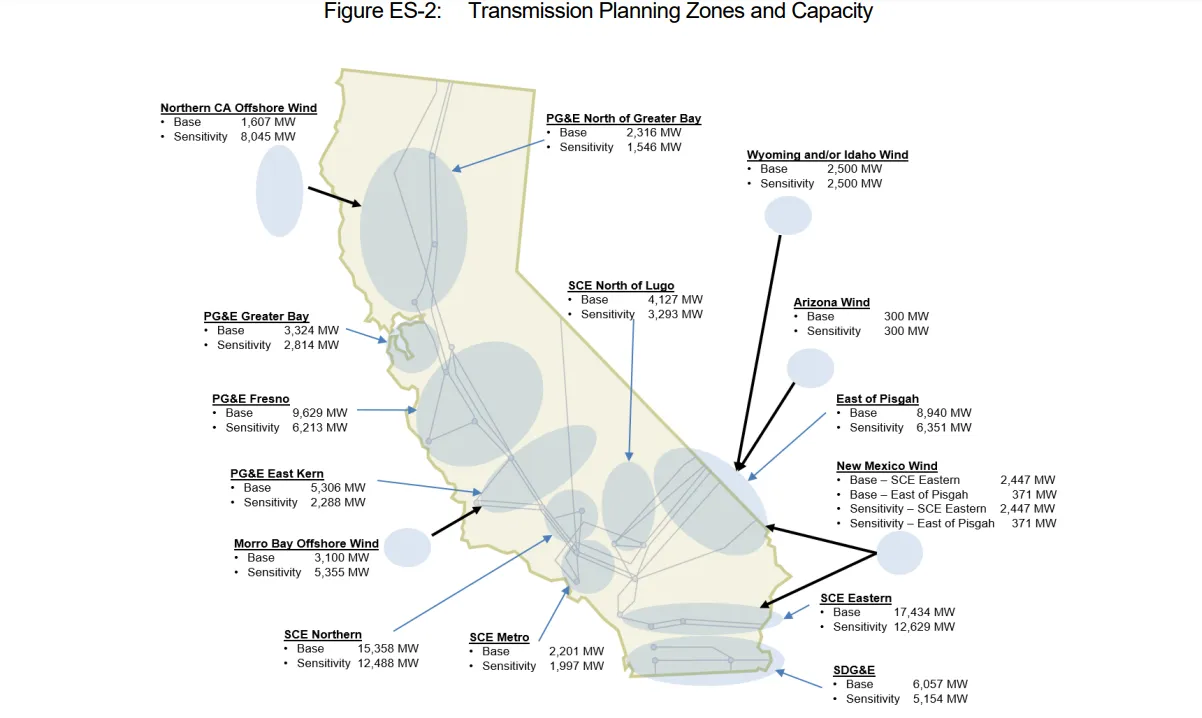
plan would also allow more than 5.6 GW of wind imports from Idaho, Wyoming and New Mexico and more than 4.7 GW of offshore wind off the state’s northern coast.
44% have solar trust issues
“A survey of 1,000 homeowners conducted by Aurora found 44% said it’s hard to know if an installation company is trustworthy”
figure has doubled in last year
In January 2024, we surveyed 1,000 U.S. adult (18+) homeowners who expressed interest in solar
Given that 10% of homeowners indicated they wanted to electrify their home before considering solar, our findings point to some homeowners viewing heat pumps as a first step to fully reaping the benefits of solar.
17% of respondents had solar, interestingly, 22% had heat pumps, and 15% had an electric vehicle (EV)
10% of homeowners had battery storage
37% of homeowners felt solar panels are more valuable when paired with whole-home electrification
half of homeowners (51%) said they believe solar is a good investment
75% of homeowners that do not have solar (but are interested) said overall system and installation costs are a big concern
54% said specifically that interest rates are too high
15% of homeowners said they were paying for their PV system through a leasing program
while only 59% of homeowners under 30 years old claimed overall costs are a concern, 76% of respondents over 30 were concerned about costs
30% of homeowners are hesitant to adopt solar panels because they don’t know if their home gets enough sun
half (51%) of homeowners are familiar with the term “Inflation Reduction Act.” Yet, only 5% of respondents said they were motivated to purchase solar due to tax incentives.
In 2023, 22% of homeowners said they were unable to find a trustworthy solar company
In 2024, the numbers doubled: 44% of respondents said it is hard to determine which solar companies are trustworthy
that in 2022 almost 80% of solar professionals said EV adoption often led to interest in solar. In 2023 it was more of the same, with 78% citing that EV adoption was leading to interest in solar.
85% of professionals reported having trouble meeting solar demand, compared to 90% in last year’s study
in 2022 supply chain issues were still at the front of the line at 28%, in 2023 they were cited by only 9% of respondents
main problem in 2023 was homeowners being reluctant to commit to quotes, at 38%. This is not only a huge jump from the previous year’s 22%, but is almost four times higher than the second most popular issue, struggling to find enough qualified employees (10%)
Top reasons homeowners backed out of committing to a solar project: Overall project costs/Poor return on investment/Concerns over moving or selling proper
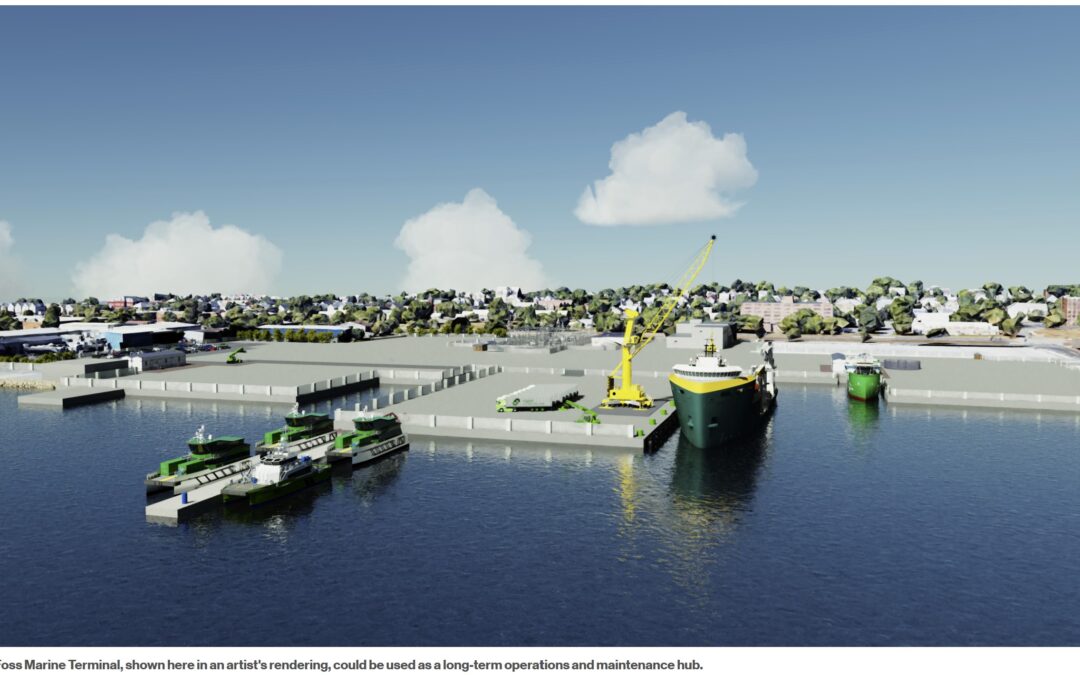
Offshore wind bids using Salem and New Bedford as home
New Bedford is still part of Vineyard Wind 2’s plan, however in a different capacity — as an operations and maintenance hub at the New Bedford Foss Marine Terminal. While staging and construction last only one to two years, operations and maintenance work is meant to last as long as the project, or up to 30 years.
Andrew Saunders, president of the New Bedford Foss Marine Terminal, said Vineyard Wind 2’s proposal for an operations hub in New Bedford would be a “huge economic benefit.” He said Foss would employ 15 to 20 people at its terminal, but that its tenants (contracted by Vineyard Wind 2) would employ hundreds.
Foss plans to build a 30,000 square-foot warehouse for the project to store important components and supplies; some would go in a climate controlled portion (for example, sensitive parts for the nacelle — the turbine’s generator).
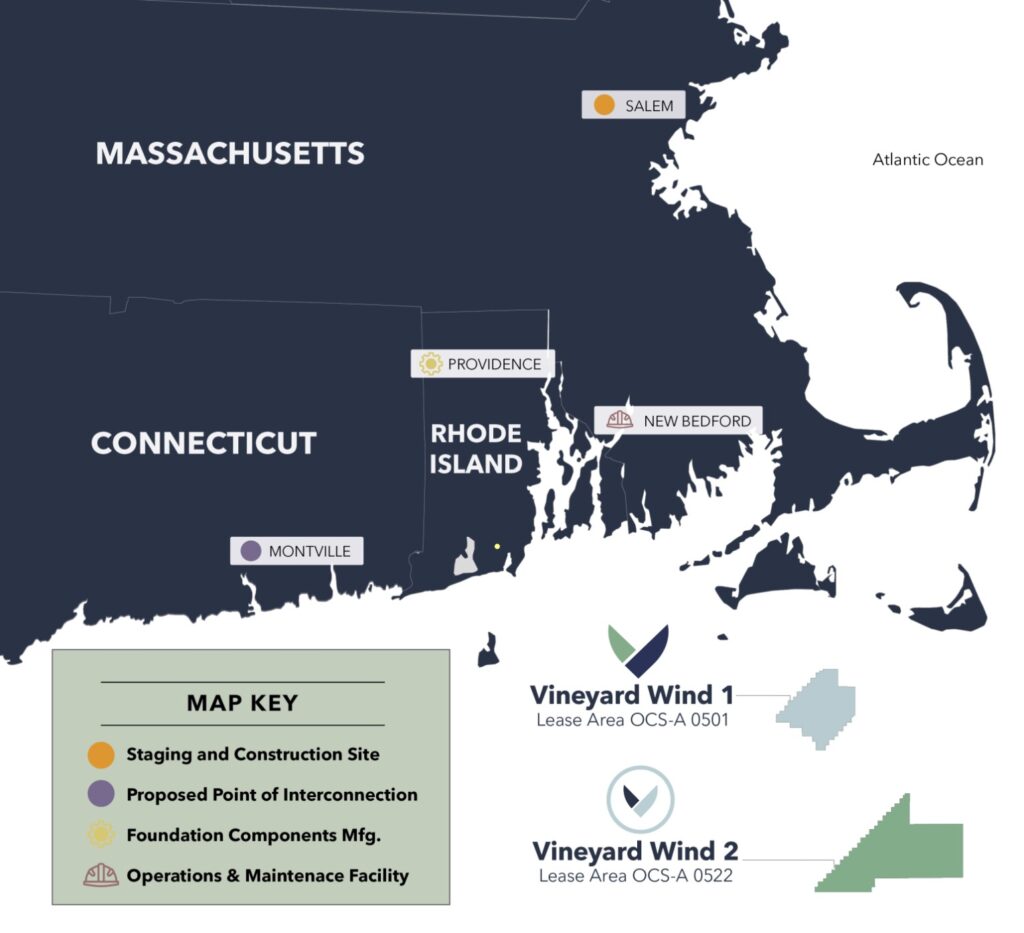
New England Wind 1, like Vineyard Wind 2, plans to use Salem as its marshaling port for construction.
Similarly, the project proposes an operations and maintenance hub in New Bedford at Shoreline Offshore, a company owned by Quinn Fisheries.
Avangrid also announced plans to build a manufacturing facility in the city for cranes that can lift heavy offshore wind equipment. The company is partnering with Danish manufacturer Liftra to build a “first-in-the-nation” crane manufacturing facility at South Coast Mills in the South End.
Finally, Avangrid also plans to use the New Bedford Foss Marine Terminal to operate its crew transfer vessels (CTVs) and service operation vessels (SOVs). The former are about 60 to 100 feet long and are used for day trips, but SOVs can scale at 250 to 300 feet and support offshore trips that last one to two weeks.
SouthCoast Wind is the only developer that has committed to establishing both operations and maintenance and staging of its project in New Bedford. That commitment, however, is contingent on Massachusetts agreeing to purchase at least half of the project’s 1,200 megawatts.
Thin pervoskite solar cells show potential in heterjunction setting
Large-scale production of Pero-Si tandems in the future is expected to use Si wafers thinner than 100 μm for both economic and sustainability reasons
We forecast that Si bottom cells for mass produced Pero-Si tandems will be based on wafers thinner than 100 μm
In our work we study challenges and opportunities related to this likely wafer thinning for the performance of the SHJ bottom cells operating in Perovskite shadow
We study SHJ cells prepared on 80 μm thick wafers in comparison to the reference cells based on 135 μm thick wafers addressing two issues: passivation and light management
We show that major wafer thickness reduction of 40% turns to only approx. 0.35%abs loss in the bottom cell efficiency
minor loss can be reduced even further using highly technological ITO/MgF2/Ag back reflector and MgF2 anti-reflection coating

These findings suggest that adopting 80 μm wafers is a viable approach for developing mass-produced Pero-Si tandems.
Solar grade sand demand up – $55 ton
must have a silica concentration of more than 99.9%, against less than 80% for construction material
high-quality sand is scarce: of the 50bn or so tonnes extracted each year, less than 1% can be used to produce regular glass. A tiny fraction of that is pure enough for solar panels.
likely to be a surge in production, especially in sectors that Xi Jinping sees as important to China’s future, such as lithium-ion batteries, electric cars and solar panels, many of which require vast amounts of sand
Prices are already hovering near record highs; last year they came to around $55 a tonne
price of high-quality sand has risen twice as much as that of lower-quality stuff over the past five years, owing to the expansion of green manufacturing and the growing popularity of smartphones
manufacturers are now looking for alternatives. One option is to refine sand used for regular glass, which tends to be 99.5% silica. The problem is that doing so is itself expensive.
black market, estimated to be worth hundreds of billions of dollars a year, is likely to grow. Australia and Brazil are perhaps best placed to profit from the legal boom,
Interesting, inside the USA, sand for the purpose of fracking is up as well over the years.
Dumpster diving for solar panels (or not probably)
being held for stealing $3,600 in solar panel hardware then turning it in for a Facebook reward, a transient Cheyenne woman could face up to 20 years in prison — as could her two alleged accomplices
Two of the three claimed they found the solar hardware while dumpster diving.

owner of Colorado Solar Co., Justin Baker, contacted the Laramie County Sheriff’s Office Feb. 27, saying someone had stolen $3,600 worth of solar equipment from his customers at their home the night before
equipment had been on a pallet in front of the home, placed there by a forklift, in multiple cardboard boxes
Baker allegedly heard three different stories from the suspects about how they came to acquire the items.
She allegedly told him they found the equipment in a dumpster in West Winds Mobile Home Park, then changed her story and said she and Stricker found the goods in a dumpster in the Willow Pond subdivision. Next, Chapman interviewed Stricker, who said he found the items at a Loaf n’ Jug on South Greeley Highway in a dumpster with a friend named Curtis. He said they were dumpster diving and looking for food, the affidavit says.
charged with two variations of felony theft, each punishable by up to 10 years in prison and $10,000 in fines

Pig landfill turning into solar power plant in Jersey
Factoring in buffers, wetlands and other undevelopable segments.. 38 acres of the property will have solar panels. The total property size is 64 acres.
developed in three separate phases
Once completed it will generate a combined 15 MW of power, which is stated will serve over 500 low and moderate income residents in the PSEG territory of Gloucester County
located on a mostly undeveloped stretch of Almonesson Road between the New Jersey Turnpike and the Big Timber Creek
From the 1940s through the 1970s the planned solar field property was used as a pig farm which received food waste from Philadelphia restaurants. The food waste was used as feed for the pigs.
from the 1930s to the 1970s the property was mostly open space. When the farming stopped operating, Mother Nature took over and trees grew into a fully wooded property.

was also used as an unapproved landfill in some parts, particularly on the Western half. Besides solid waste in areas, it introduced contaminants into the soil and groundwater. To this day the property has never been closed (contained) nor environmentally monitored.
As part of the development of the solar field, the developer is required to close the property under an agreement (and guidance) with the State of New Jersey, as well as continue monitoring it for 30 years after closure.
Project documents state the source of the landfill material consisted of domestic food wastes mixed with inorganic solid wastes (plates, silver ware, bottles, etc.). Deptford Township’s resolution on the approval of the project describes the contamination as “contaminated with municipal refuse from feeding operations. In general, the refuse was disposed of in pits or mixed in with soil in the upper layers of the site”
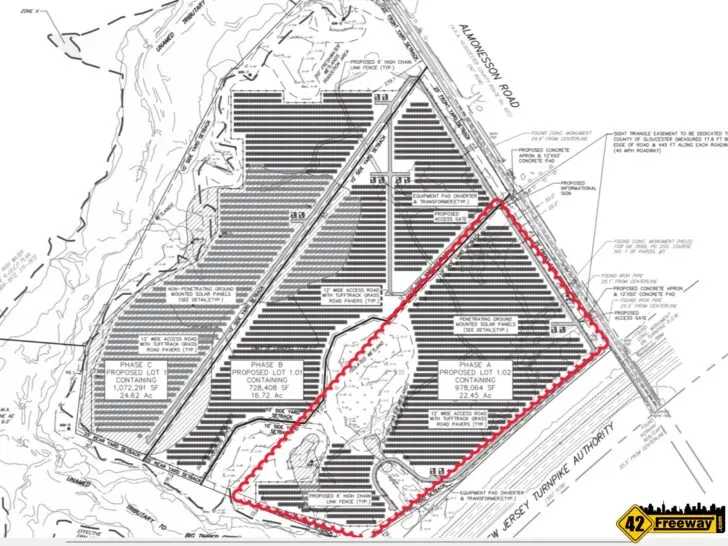
prior use decades ago introduced contaminants in the soil and groundwater, including PCBs, pesticides, and metals (arsenic, lead, and vanadium) in soil and sediments and trichloroethene (TCE), metals (arsenic, cadmium, lead, and mercury), and landfill indicator nitrogen (as ammonia) in ground water.
likely why residential housing developers did not grab up this property 30 years ago to build homes!
Solar plus blueberry agrivoltaic results mixed in Maine
Shade from the solar panels is significantly reducing blueberry yield. Bushes planted in shaded portions underneath solar panels produced just 9 percent of the blueberries compared to bushes planted in rows between panels.
Wild blueberries “can handle some shade, because when they’re grown in the woods they are shaded and they still grow,” Calderwood said. But when sunlight levels dip too low, blueberries put more energy into producing leaves rather than fruit, so they can catch what little light may filter through to the understory.
Bushes with more leaves require more pruning, Calderwood said, noting that the shaded areas also saw lots of weeds and a high incidence of disease.
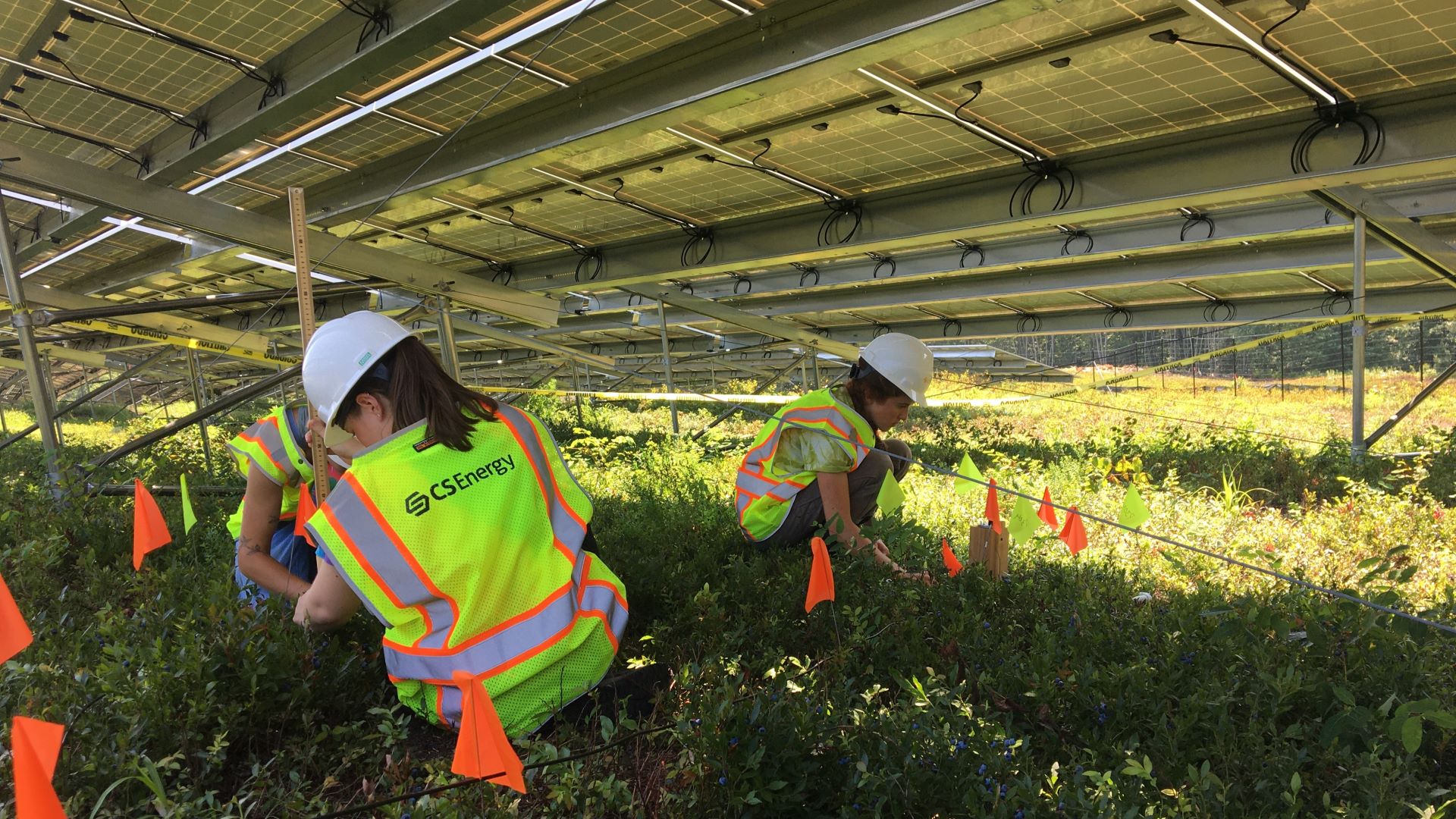
A principal aim of the study was to determine what impact installing the solar panels had on the blueberry plants. To measure this, researchers worked with BlueWave to designate three areas with varying levels of construction precautions.
In the “standard” area, no precautions were taken; in the “mindful” area, construction and foot traffic were limited, and equipment could only rotate 90 degrees; in the “careful” area, protective coverings were placed over the blueberry plants, with even more limits on equipment rotation and foot traffic.
“We didn’t see any statistical difference between those treatments, meaning that the blueberry recovered well,” Calderwood said.
BlueWave is already using the Rockport results to guide a blueberry project in Massachusetts. The company plans to introduce wider rows and build solar panels on an axis that allows them to pivot and track the sun throughout the day, letting in more light for plants.
Robertson-DuBois said building a solar farm suited for agriculture is more expensive than other solar projects: It requires more cable to space the modules farther apart and taller mounts to give farmers room.
Largest public solar companies in the world in 2024
15. ReNew Energy Global Plc (NASDAQ:RNW) Market Cap as of March 12: $2.42 billion
14. Clearway Energy, Inc. (NYSE:CWEN); Market Cap as of March 12: $2.55 billion
13. Risen Energy Co Ltd (SHE:300118); Market Cap as of March 12: $2.66 billion
12. Shanghai Aiko Solar Energy Co Ltd (SHA:600732); Market Cap as of March 12: $4.04 billion
11. SolarEdge Technologies, Inc. (NASDAQ:SEDG); Market Cap as of March 12: $4.12 billion
10. GCL Technology Holdings Limited (OTC:GCPEF); Market Cap as of March 12: $4.44 billion
9. Xinyi Solar Holdings Limited (OTC:XISHY); Market Cap as of March 12: $7.31 billion
8. Nextracker Inc. (NASDAQ:NXT); Market Cap as of March 12: $8.21 billion
7. Trina Solar Co Ltd (SHA:688599); Market Cap as of March 12: $8.22 billion
6. Brookfield Renewable Corporation (NYSE:BEPC); Market Cap as of March 12: $9.18 billion
5. JA Solar Technology Co Ltd (SHE:002459); Market Cap as of March 12: $9.20 billion
4. Enphase Energy, Inc. (NASDAQ:ENPH); Market Cap as of March 12: $16.43 billion
3. First Solar, Inc. (NASDAQ:FSLR); Market Cap as of March 12: $17.03 billion
2. Adani Green Energy Ltd (NSE:ADANIGREEN); Market Cap as of March 12: $37.42 billion
1. NextEra Energy, Inc. (NYSE:NEE); Market Cap as of March 12: $117.29 billion
Floating solar panel research – optimizing system sizes to manage waves
novel modular floating PV (FPV) solution to assess the behavior of offshore, multi-connected modules under combined wave-wind conditions
“FPV is a complex multi-body system under the coupling action of wind, wave, current, and other multi-physical fields,” the study noted. “It is therefore of immense importance to develop robust engineering methodologies and models to design FPV systems applied to offshore environments.”
as the number of modules increases, motion responses become more pronounced, and the 2 x 2 platform experienced the most significant pitch response of the configurations studied
additional movement generated by hinged connections resulted in “non-negligible” dynamic response for multi-body FPV systems, while systems using fixed connections showed no significant dynamic response
mooring tension of systems with hinged connections was greater than that of systems with fixed connections
created the FPV platforms using cylindrical pontoons and heave plates
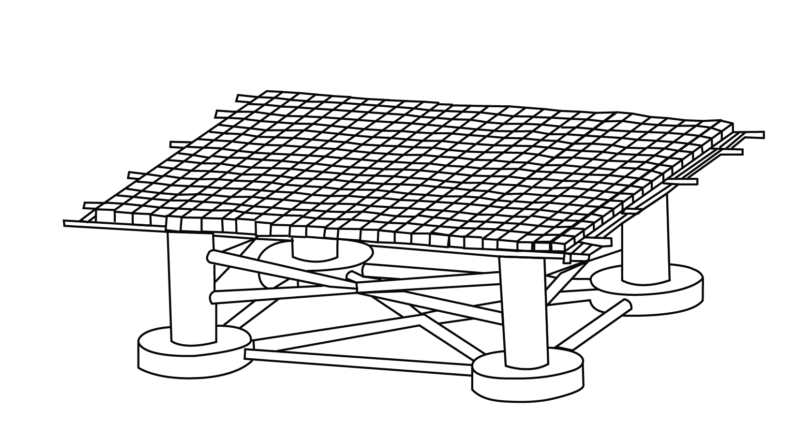
study emphasizes that heave response is influenced by the ratio of mass to stiffness
team recommends an installation angle of at least 15 degrees for a multi-body FPV system, to reduce both motion and structural responses
New electricity purchase rate for small scale French solar
new tariffs will range from €0.153 (0.17)/kWh for installations below 3 kW in size to €0.117/kWh for arrays ranging in size from 100 kW to 500 kW
French renewable energy association, Syndicat des énergies renouvelables (SER), said that the new provisions will reduce tariffs less than expected
rates for PV systems of up to 9 kW will be lowered by 4.4% instead of 14.2%, while those for installations between 100 kW and 500 kW in size will be reduced by 3.1% instead of 13%
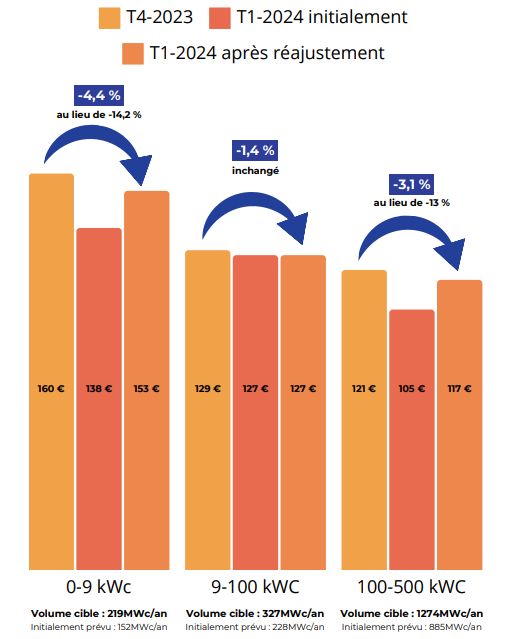
tariffs for systems ranging in size from 9 kW to 100 kW will be reduced by 1.4%, as originally planned
JinkoSolar – world’s largest solar panel manufacturer, delivers 78.5 GW in 2023
The world’s largest solar panel manufacturer for 2023 was Jinko Solar.
78.5 GW of global shipmentsshipments increased by 76.4% year on year
turnover of CNY 118.68 billion ($16.72 billion), up 42.8% from 2022
net profit of CNY 3.45 billion
gross margin at 16.0%, compared to 14.8% in 2022
shipment in the fourth quarter was 26.3 GW
outlook for 2024, JinkoSolar said it hopes to ship between 100 GW and 110 GW
production capacity for mono wafers, solar cells and solar modules to reach 120 GW, 110 GW and 130 GW, respectively, by the end of 2024
By then, we believe mass-produced N-type cell efficiency will have reached 26.5%
end of the fourth quarter, we became the first module manufacturer in the world to have delivered a total of 210 GW solar modules, covering over 190 countries and regions
Frameless panels “ensure an annual power generation increase of 6% to 15%”?
DAH Solar has developed new TOPCon solar modules with a frameless frontside to improve drainage and allow rain to wash away dust
“It is also capable of preventing snow or sand accumulation, which may ensure an annual power generation increase of 6% to 15%.”
four versions, ranging from 570 W to 585 W nominal power, with a power conversion efficiency of 22.07% to 22.65%
double-glass panels measure 2,278 mm x 1,134 x 32 mm and weigh 32 kg
15-year product warranty and a 30-year power output guarantee
degradation in the first year is purportedly 1% and the 30-year end power output is guaranteed to be no less than 87.4% of the nominal output power
Seaweed farm to be developed within offshore wind farm
consortium to develop the world’s first commercial-scale seaweed farm located within an offshore wind farm
10-hectare farm is planned to become operational in autumn 2024 when it will be deployed and seeded, with the first harvest expected to be in spring 2025
seaweed absorbs nitrogen, phosphorus, and carbon dioxide and produces oxygen, thereby being part of the solution to climate change and ocean acidification. In doing this, it produces valuable biomass with a wide range of uses from pharmaceuticals to animal feed to fertilisers
Fossil fuel money is lying to you about whales and wind farms
This is a longer article, and you should probably read it. Understand that there are plenty of people that will do plenty of things you might consider immoral for money or ideology. They will lie, they will cheat, they will steal.
The report found that while wind foes circulated voluminous studies, white papers and regulatory comments that gave the impression of rigor, they relied on fake experts and cherry-picked or misrepresented data — mainstays of the larger climate-denial movement.
The most effective protections would involve stricter regulations on commercial fishing, according to Kenney. But, he says, “the fishing industry fights tooth and nail every step of the way.”
Electrification pays for itself in New Zealand
New Zealand is one of the first countries in the world to reach an electrification tipping point
combination of EVs and electric appliances are cheaper over the lifetime of the machines, even with higher upfront costs or a 5.5 per cent interest rate for finance
homes currently using gas or LPG appliances and petrol vehicles could save more than $1,000 per year if they electrify and get their power from a combination of rooftop solar, home battery, and the existing electricity grid no
fully electrifying a home and vehicles could save $1500 to $5000 a year with annual GHG emissions being significantly lower, and that electricity prices from solar can be around one third the cost /kWh when purchased from the grid
overall energy use would fall with electrification to less than half of what an average household uses today as petrol, diesel, gas and wood are avoided. But electricity use would be two to three times as high.
Cromwell, South Island, cherry farm is saving about $60,000 in diesel costs a year by using 20 new electric vehicles, including a tractor
electricity use is nine-times higher than the previous farmer of his land, but use at peak times has not increased so network upgrades weren’t needed, and rooftop solar provides “significant” amounts of energy
China aiming for 750 GW of solar modules delivered in 2024
China Photovoltaic Industry Association’s (CPIA) roadmap for Chinese solar industry sees exponential manufacturing growth across the industrial chain
The country will increase the production of polysilicon, wafers, cells and modules by around 50% this year
The industry employed 3.53 million people in 2022, and the numbers will likely grow to between 4.875 million and 5.808 million by 2025
solar module manufacturers are gearing up to deliver more than 750 GW of modules in 2024, representing over 50% annual growth over the 499 GW they delivered in 2023
manufacturing industry produce 820 GW of solar cells, up from the 545 GW in 2023
Silicon wafer output is also expected to exceed 935 GW this year considering the expansion plans of leading companies in the space. Last year, the country rolled out close to 622 GW, having gone up 67.5% YoY
delivering 1.43 million tons of polysilicon last year with a 67% annual increase, China is looking at over 2.1 million tons this year
forecasts China to install up to 220 GW AC new PV additions with land constraints and grid capacity as the major challenges, after growing to 216.30 GW AC in 2023
average thickness of polysilicon wafers in 2023 was 170 μm. While the CPIA does not see any change to this value this year, it believes it can change in the later years
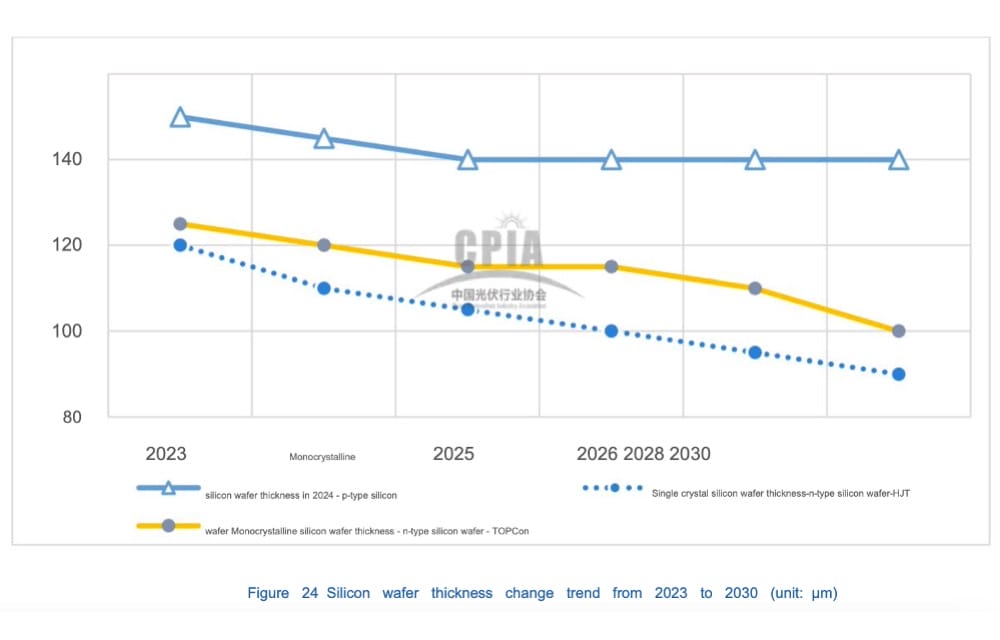
Installed close to 22.6 GW of new domestic energy storage capacity with an average storage time of 2.1 hours.
As regulatory support for storage builds up parallel to technological improvements bringing down its costs, China may exceed 31 GW capacity for this technology in 2025
German emissions down 10% – “on course for the first time”
Germany’s emissions fell by record 10.1% in 2023
Europe’s biggest economy is trying to cut their emissions by 65 per cent, compared with 1990, by 2030. These latest stats put them on track to reach a cut of almost 64 per cent by that date.
country’s environmental protection agency said that Germany emitted about 673 million tons of greenhouse gases in 2023, a decline of 76 million tons or 10.1%, compared with the previous year. It was the strongest decline since 1990
Germany was sixth in the world for how much new solar it installed
It’s a complex economy right now though…
German economy dodges recession despite shrinking 0.3% in 2023.
“It is worrying that the German economy has hardly grown at all since the outbreak of coronavirus,” Commerzbank’s chief economist Joerg Kraemer said. “This is rare and brings back memories of the years following the bursting of the stock market bubble at the start of the millennium.”
Second largest module manufacturer firing 30% of workforce
Longi plans to trim as much as 30% of its workforce
last year totaled about 80,000 at its peak
employment at Longi had surged from the 4,068 people it had in 2012, when the manufacturer went public on the Shanghai Stock Exchange. The company reported 60,601 of employees at the end of 2022, and hiring continued well into 2023, according to the people
factories using older technologies have seen more job cuts than other units, some of the people said
company had about $7.4 billion in cash and equivalents at the end of 2022
previous efforts to cut costs fall short, including the cancelation of free afternoon tea, shrinking budgets for business trips and being told to only print in black-and-white unless approved to do otherwise by supervisors
the financial pressures sent its net income plunging 44% to 2.52 billion yuan ($350 million) in the third quarter of 2023
Company President Li Zhenguo said in October that the firm “made a mistake” in not being aggressive enough in price competition with peers and was likely to miss its annual shipment target
company’s shares have fallen about 70% from their peak in 2021
Slowing solar kills humans
The best way to preserve the status quo is to destroy the machinery that promises a change to existing ways.
European Union, which doesn’t impose tariffs on photovoltaic imports, installed nearly twice as much solar last year as the US, and more than seven times as much as India, despite weather that’s far less suited for the technology
Beijing can’t stop the sun from shining on Chinese-made solar panels in Germany — but Moscow really did cut the flow of gas to Europe
Local content requirements and tariff barriers on solar panels, designed to build up domestic manufacturing industries, have operated in many places (including India, the US, South Africa, and Indonesia) as soft bans that have pushed up costs, slowed deployments, and favored incumbent fossil-fired power generation and emissions.
An acceleration in trade wars will only slow our path to zero.
Lithium battery cells tripling manufacturing volume between 2022 and 2025
report from Clean Energy Associates (CEA) outlined that by 2025, global manufacturing of lithium-ion battery (LIB) cells is expected to triple from 2022 levels.
collapsing lithium prices has led to a cooling-off in demand for chemical alternatives to the mainstream nickel manganese cobalt (NMC) and lithium-ferro-phosphate (LFP) chemistries
more evolutionary chemistries like lithium manganese iron phosphate (LMFP) may find their way into electric vehicles and energy storage sectors as early as 2025
negative impact on commercialization for new technologies like sodium-ion batteries
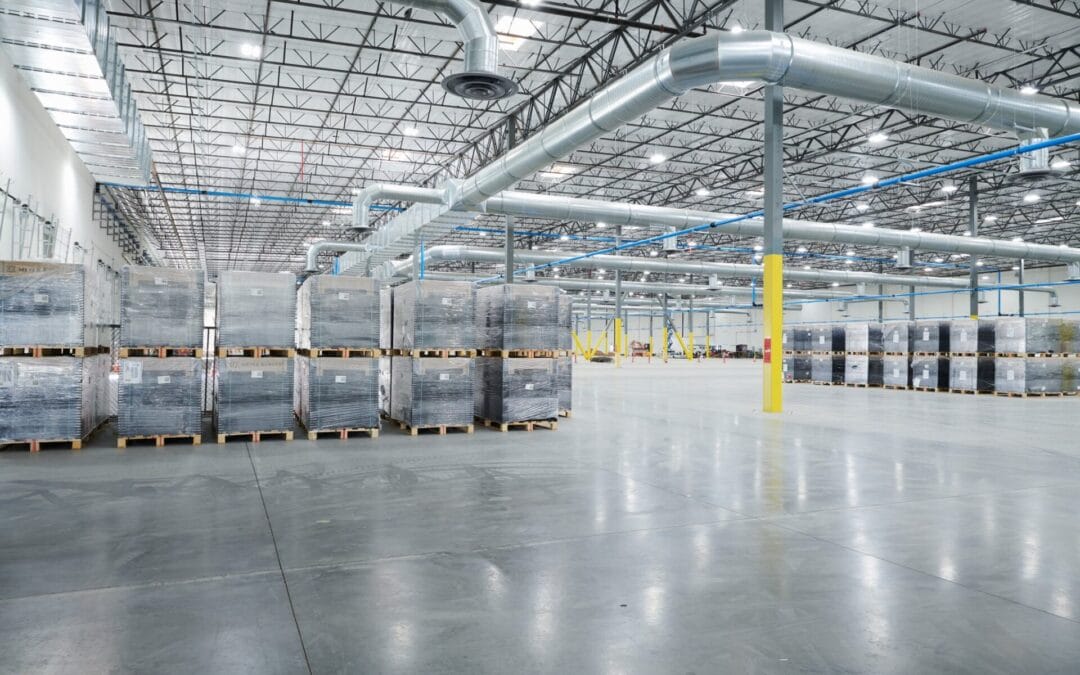
$0.143/W earnings projected at scale in US, Meyer Burger posts large loss for 2023
Meyer Burger has posted financial results for 2023, with net loss increasing by 318% to CHF292 million (US$330.6 million)
“prices from Chinese suppliers in Europe, coupled with a sharp rise in Chinese production overcapacity and a lack of market protection, led to unprecedented distortions in the European solar market, which had a serious impact on Meyer Burger’s earnings”
company said the proceeds from potential debt financing sources, together with the proceeds from the capital increase, will enable it to start module production in a 2GW plant in Goodyear in the US state of Arizona by the end of the second quarter of 2024. The 2GW cell production plant in Colorado Springs, Colorado, is also expected to ramp up by the end of 2024.
“Assuming that cell and module production at the US sites can be ramped up as planned, the group expects to generate an annual EBITDA of around CHF250 (US$282.63) million per year in the medium term from its business in the US,”
That calculates to $0.1413 per watt of revenue on those 2 GW of capacity that we might see in 2025. If solar project’s price ranges from $1.00 to $3.00/Wdc, then a 10% tax credit adder for buying domestic content hardware is worth $0.10 to $0.30/Wdc.
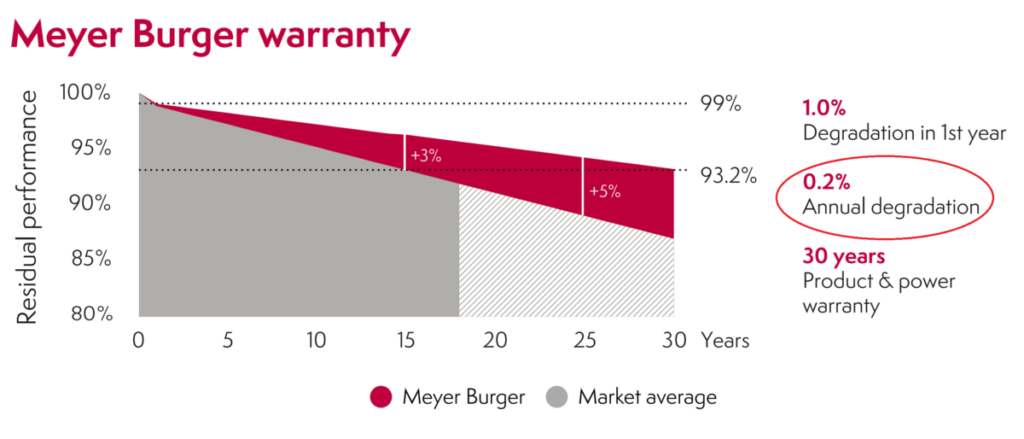
Burger modules have a degradation value of 0.2% per year – however – the CEO has hinted that standard accelerated testing situations found no degradation. A 3 MWac solar project financial model we’re working has 0.5% module degradation, and 0.5% general system losses. If we moved the module degradation to 0.2%, about a half % higher return of investment was had. Going to zero popped it a full percent. This is a long term model though, 35 years, with much of that ROI pumping volume coming from the tail end of the facility. Do people truly purchase production in years 26 through 35?
The company has just over 300 MW of product they need to move, at probably decently higher costs.

Bluewave seeking solar agrivoltaic projects in Massachusetts
three-array, 26,000-panel, 10.9-megawatt project
projects allow the land to be used for solar energy production, while still allowing for farmers to use the land for growing crops or grazing for their herds
construction of a 2.5-megawatt array with about 4,368 individual panels mounted on a single-axis tracker system at least 10 feet off the ground that will allow the array to follow the sun throughout the day
plan is to have Finicky Farm LLC manage the field, which will have enough space underneath and between solar panels for equipment, and plant historical crops — potatoes, grain corn, peppers and pumpkins — along with some new crops. Animal grazing will also be implemented.
“solar arrays…have low levels of electromagnetic radiation, much less than everyday appliances”
![]()
Article included a link to the town’s website showing off the project. The company is using Terratrack trackers to lift the module base10 feet off of the ground, and seven feet when they’re in a stowed position.
Solar entering a new phase? Massachusetts’ SMART program aging out.
Due to higher electricity rates and the declining incentive structure of the SMART program, some applications may receive an incentive payment rate of $0.00. Further information on which blocks this is occurring in is available here. In these instances, the Department advises solar installers work with their customers to evaluate the benefits of participating directly in the RPS market.
The design of the SMART program was to keep the return of investment of solar at a certain rate in order to motivate installations. It was structured in a manner that as the price of electricity goes up, the incentive goes down. The price of electricity has definitely increased in Massachusetts since the program was put in place in later 2018.
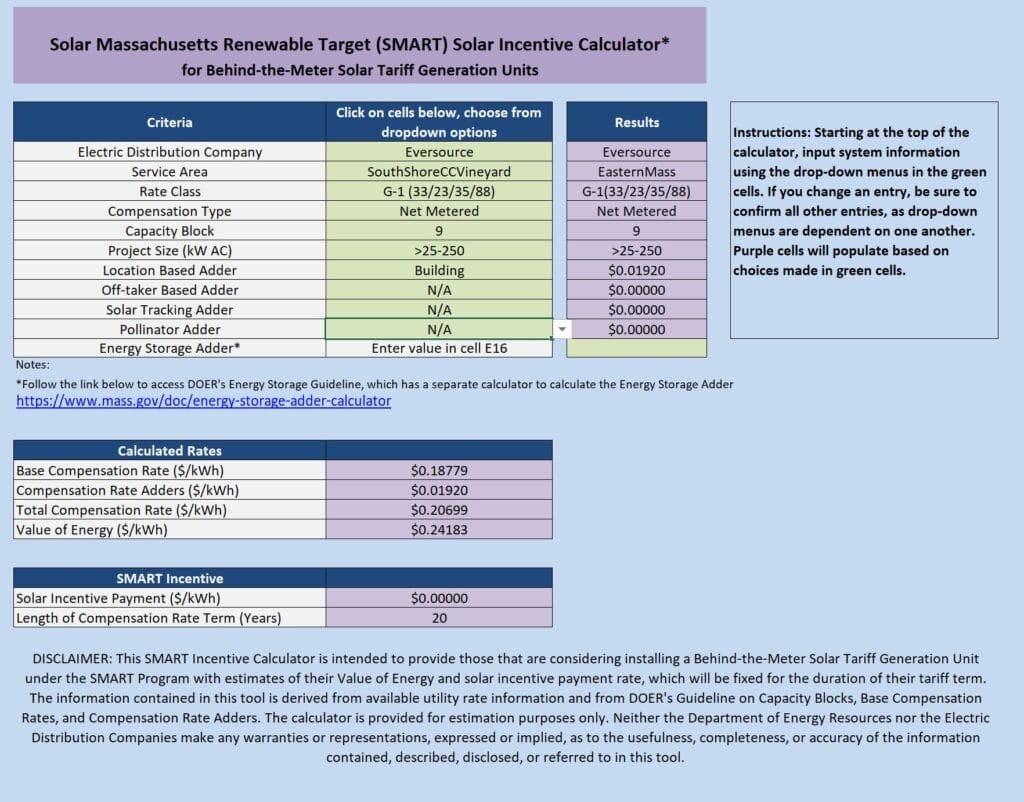
Recently, the state updated the SMART program’s documentation, noting that most behind the meter solar power projects no longer earn an incentive. The incentive for a rooftop solar power project between 25 kWac and 250 kWac in Eversource – one of the highest incentive regions of the state – is now $0.00000. Lots of zeros, but that’s how electricity is accounted for.
That we are now at a stage where the price of electricity is high enough that the SMART program no longer generate revenue, says we might be at a tipping point in New England.
$80 million for 92 solar power projects, 73 MWp
portfolio consists of 92 photovoltaic (PV) solar power plants with a total capacity of 73 MWp
financing of over EUR 73 million (USD 80m) to fund the development and construction
large part of the profolio, 70%, is focused on self-consumption
75% is related to large enterprises in commerce and industry, while 68% of the projects will be located in the northern part of the country in a sign that self-consumption is increasingly linked to electricity prices
“It’s crucial for us to play our part.”
Rt Rev Ruth Worsley, has voiced support for All Saints Church in Bedworth, as it plans to install solar panels on its roof despite its Grade II listed status
late-victorian All Saints Church, built between 1888 and 1890, holds significant historical value and is part of Bedworth’s conservation area
local council’s planners are hesitant due to historical preservation concerns. They have stressed the need to prioritise historical preservation, citing potential harm to the building and its surroundings.
proposed installation of 68 solar panels on the church’s south-facing roof promises an 18 per cent reduction in carbon dioxide emissions annually and a 40 per cent decrease in electricity bills
Everyday O&M a nuisance, modules improving, billions in preventable losses
company found $177.7 million in preventable annualized revenue losses
dataset comprises 125 GW of PV assets, spanning 41 countries
found average losses of $4,696 per MW, though losses varied regionally
Since 2019, the average losses from underperformance have increased from a 1.61% average power loss, to 4.47% in 2023. Raptor Maps said this equates to an internal rate of return at loss of at least 190 basis points in a 100 MW solar asset.
2023 survey, the company found “many operators identified preventative maintenance visual inspections as a significant source of time wastage, and a large number of respondents also identified validating nuisance alarms as another way time is wasted.”
Inverter faults, string outages, and combiner faults contributed power losses of 1.91%, 0.90%, and 0.81% respectively. Instances of tracker issues have also risen from 0.26% in 2022 to 0.46% in 2023.
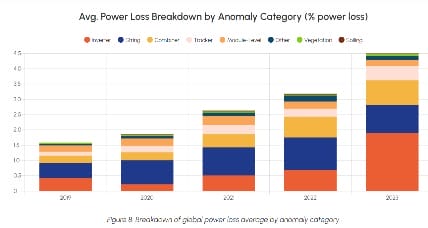
module performance has improved slightly, with losses decreasing by about 12% year-over-year
20 gigawatts inverter factory coming to the US
Power Electronics plans to invest €300 million ($328 million) to expand its inverter production capacity in Spain and the United States
current production capacity is 30 GW, and it will increase manufacturing capacity in the United States by more than 20 GW by 2026
factory will cover an area of 174,015 square meters and “will be designed with the latest manufacturing and assembly technologies to serve as an optimal center for the manufacturing and distribution of its products throughout the country,”
plan also foresees the completion of a new plant in Llíria, Spain, for the Electric Mobility division
Electricity just beats inflation in 2023, expected to drop in 2024
U.S. electricity prices rose 3.6% over the last 12 months, outstripping the broader inflation rate of 3.2%
Transmission costs and volatile fuel prices are the primary drivers of higher power bills
Residential customers will pay about 16.23 cents/kWh in 2025, up from 15.98 cents/kWh last year

EIA said it expected 2025 residential prices to average 16.11 cents/kWh in 2025. For this year, the government forecaster expects prices to average 15.87 cents/kWh
Spring solar records across Europe
In most analyzed markets, there were the highest daily photovoltaic energy production levels ever registered for a March month
list starts with the German market, which produced 249 GWh on March 8, which is also the highest value since mid?September. The Spanish market generated 137 GWh on two days in a row, on March 5 and 6, a level last seen in the summer, on August 31. The French market generated 85 GWh on March 7, which is also the highest value since the end of September. The list is rounded off by Portugal, where solar energy production reached 13 GWh on March 5, slightly below the records registered in February, but still the highest ever registered in a March month
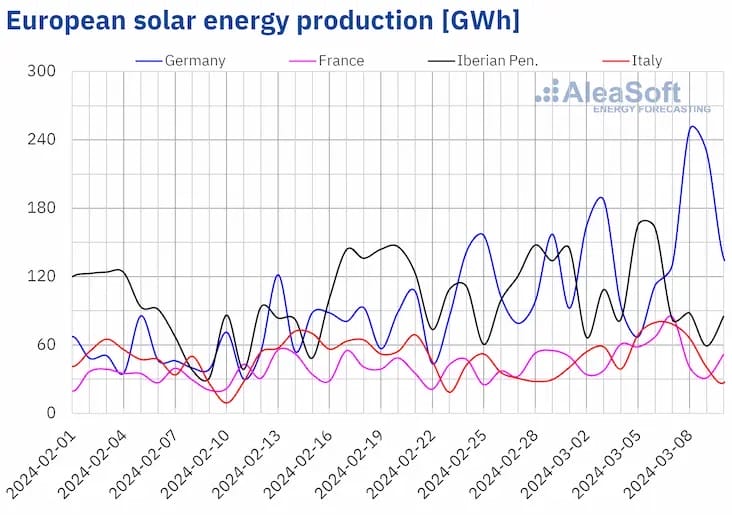
Significant PPA signed at soon to be largest Australian solar farm
SmartestEnergy said on Thursday that the “significant long-term” power purchase agreement (PPA) will see it source electricity from the 400MW stage 1 of the New England solar farm to onsell to its customers.
Acen Australia near Uralla in New South Wales, stands to be the biggest operating solar plant in Australia when its full capacity of 720 MW across two stages is complete
shares its location with more than 2,000 merino sheep, a number that is expected to triple over the course of this year
for now, title of largest, has only completed the first 400 MW stage and so has to share top billing with Neoen Australia’s Western Downs solar farm in Queensland
Mines replace diesel with solar, storage, and gas
replaced six diesel power stations with four hybrid solar, battery and gas systems
new systems, which have a combined capacity of 82MW, under a seven-year build, own and operate agreement
combined capacity of 28MW of solar, 11.5MW of battery energy storage, and 42.5MW of high-efficiency gas generation
four hybrid power systems will displace 38 million litres of diesel each year
based around grid forming battery technology
hybrid power system deployed at Westgold’s Tuckabianna facility was fully commissioned in August 2023 and has since achieved an average solar penetration of 31% between November 2023 and January 2024, peaking at 36.9% in December
Australia’s largest energy user seeking wind and solar
biggest single energy consumer in Australia, Tomalgo smelter – with annual demand of more than 8 terawatt hours
majority owner saying nuclear is out of the question because it is too slow and too expensive
first steps towards a new tender will be launched, “Next week, we’re launching an RFP (request for proposals) for Tomago”
‘very, very keen to go down a very similar process of assessing what projects exist in New South Wales’
Further details were not released, but it is likely to be similar in scope to the 5 GW of new capacity required by Rio Tinto for its Gladstone smelters and refineries.
Medium and heavy duty trucks electrifying quicker than expected
Over 5,600 electric or fuel cell medium- and heavy-duty trucks were sold in China in the final month of the year
10% of the total number of those class vehicle sales
all types of commercial EV sales in China to over 330,000 for the year
Light commercial EVs in China took 16% of the market in December
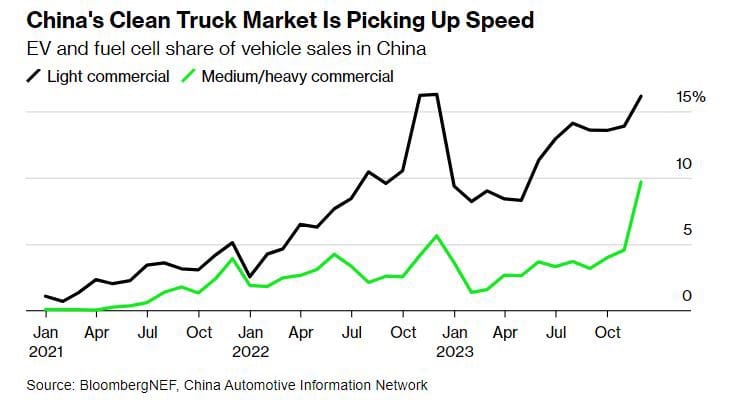
hydrogen fuel cells are finally making their presence felt, with over 1,000 fuel cell-powered heavy trucks sold in December
battery-swappable vehicles sold in the country remains a niche technology for passenger vehicles, however almost half of all heavy battery electric trucks sold last year in China had swappable batteries. That’s up from 34% in 2021.
Transmission needs for MA and New England considered
will require that electric utilities before the state’s Department of Public Utilities (DPU) show that they have evaluated GETs, advanced reconductoring, and storage as a transmission asset when making decisions about capital allocation in upgrading the grid
study found that grid congestion between New England and New York has been so severe that during one extreme weather event – the ‘Bomb Cyclone’ storm of 2018 – each additional gigawatt (GW) of transmission capacity could have saved between $30 and $40 million dollars in lost economic productivity
EV prices down 13% over last year
average price paid for an EV in February was $52,314, down from a revised $54,863 in January
EV transaction prices in February were lower year-over-year by 12.8%, an accelerating decline compared to January, when prices were lower year-over-year by 11.6%
prices for the Model Y last month, estimated at $49,363, were the lowest on record and were lower versus February 2023 by 16.2%
Model 3 transaction prices last month, at $43,614, were lower year-over-year by 12%
important to acknowledge that EVs remain priced above mainstream non-luxury vehicles by nearly 19%
New Span smart home electric panels
SPAN Panel 48 – The largest addition to the SPAN Panel family, the SPAN Panel 48 is geared towards new home construction, enabling builders to avoid expensive infrastructure costs when building all-electric or future electric homes, with best-in-class energy management, storage and charging capabilities of SPAN Panel 32.
SPAN Panel 32 – Currently available and deployed across the U.S., SPAN Panel 32 serves both the retrofit and new home construction categories, providing software-defined, whole-home backup management when paired with one of several compatible energy storage systems, as well as reducing the costs of electrification.
SPAN Panel 16/24 – Focused on retrofit electrification, SPAN Panel 16/24 is a field-adaptable, smaller Panel form factor that enables SPAN PowerUp functionality for major electric load additions, reducing both hardware and labor costs compared to larger panel form factors.
SPAN Meter 8 – Designed to offer unparalleled capabilities when paired with smart meters, SPAN Meter 8 offers utility/grid operators advanced metering, submetering, demand flexibility and better utilization of the distribution infrastructure.
also a bigger 48-breaker panel coming for new homes

22 gigawatts of small nuclear reactors, potentially
22 GW of small modular reactor projects representing $176 billion in potential investment are in the works across the world
U.S. has nearly 4 GW in announced SMR projects in addition to almost 3 GW in early development or pre-development stages
Poland and Canada come in second and third, with around 2 GW each in planned capacity
Polish regulators recently approved plans to build up to 24 GE Hitachi BWRX-300 reactors at six sites across the country
Solar stocks performing terribly
Invesco Solar ETF fell by 21% for January 2024, while the S&P 500 increased by 2% and the DJIA increased by 1%
top three solar stocks for the month of January 2024 were Atlantica Sustainable Infrastructure plc, down 11%, and ReNew Energy Global Plc and Clearway Energy Inc., which both fell by 12%
Logistical challenges emerged within the solar market, potentially bolstering pricing dynamics. That, coupled with liquidity issues, seems to be causing unease in the solar industry
worst performers in January 2024 in the United States markets were Emeren Group Ltd, SunPower Corp., and Maxeon Solar Technologies, Ltd., which all fell 37%
module vendors are contemplating price elevation strategies, as security concerns in the Red Sea and a drought in the Panama Canal are presenting logistical hurdles that could additionally bolster pricing
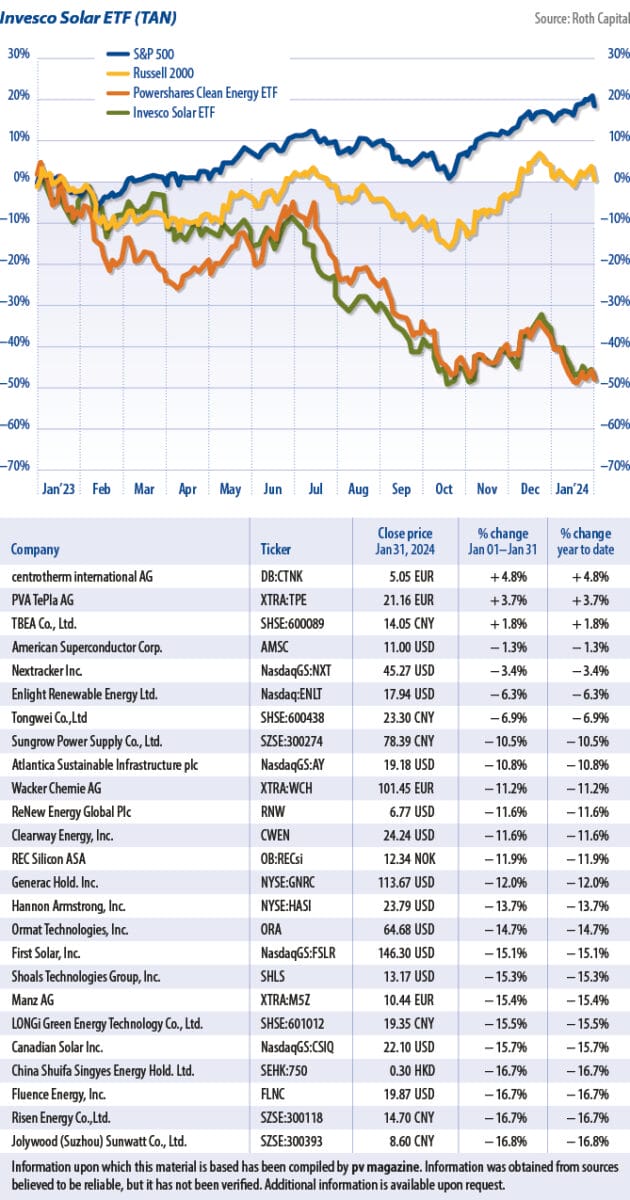
40 GW solar polysilicon factory cancelled
Jolywood said it has halted plans to set up a silicon metal plant and a polysilicon production facility in Gujiao, Shanxi province. The company originally unveiled the CNY 14 billion ($1.9 billion) plan in March 2022. It said it is halting the project due to current conditions in the upstream silicon PV market.
100,000 metric tons of polysilicon can be used to manufacture about 40 GW of solar panels.
One million grams per metric tons, times 100,000 metric tons is 100 billion grams. At 2.5 grams of polysilicon per watt of solar power – that’s 40 billion watts, which is 40 gigawatts.
Record wireless car charging efficiency – 100 kW at 96%
demonstrated that a light-duty passenger electric vehicle can be wirelessly charged at 100-kW with 96% efficiency using polyphase electromagnetic coupling coils with rotating magnetic fields
patented system transferred power to a Hyundai Kona EV across a five-inch airgap using electromagnetic fields
highest power density in the world for a wireless charging system for this class of vehicle
densities 8-10 times higher than conventional coil technology and can increase battery charge state by 50% in under 20 minutes
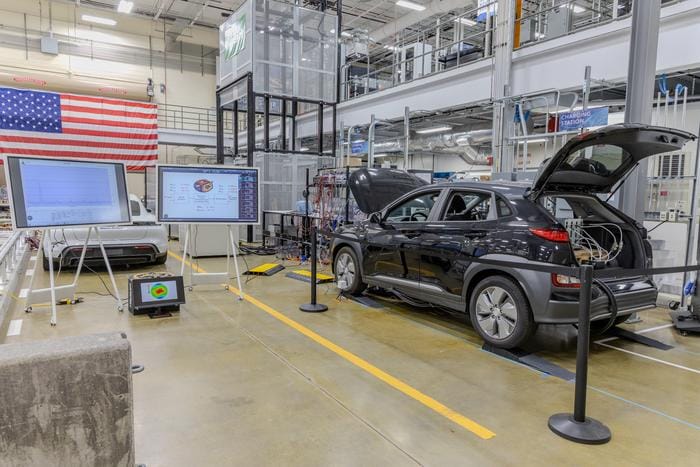
Recycled steel for solar modules 1/10th emissions of aluminum
compared with traditional virgin material aluminum module frames shipped from China, U.S.-made module frames made from recycled steel show a 90.4% reduction in greenhouse gas emissions. In Germany, the frames have a 94.7% carbon advantage.
Boundless estimates the greenhouse gas footprint of Origami Solar’s steel module frames at 9.25 kilograms (kg) of carbon dioxide equivalent per 2 meter by 1 meter frame produced in the U.S.
“The estimated Fossil Energy Footprint of Origami Solar’s steel module frame is 71.8 megajoules (MJ) in the United States and 62.2 MJ in Germany per 2 by 1-meter frame, compared to 920 MJ for a conventional virgin aluminum frame produced in China using an extrusion production process,” said the report.
The company said the improved carbon embodiment would result in a reduction of 80 kg of emissions per module or 200 metric tons per MW.
First Middle Eastern polysilicon factory – 40 GW/yr
Construction has begun on a $1.35 billion polysilicon production facility in Oman
producing 100,000 metric tons of metallurgical silicon per year
Equal to roughly 40 GW of solar panel capacity/yr at 2.5 grams/watt
will occupy an area of 160,000 square meters
United Solar Polysilicon (FZC) is manufacturer
production process will involve pouring liquid metallic silicon from a furnace into molds, then cooling, casting, grinding and packing the ore for global export
billed the project as the first of its kind in the Middle East
in January, Chinese solar material manufacturer Shuangliang Eco-Energy Co announced it received a $58.3 million equipment order from United Solar Polysilicon (FZC) SPC and will supply polycrystalline silicon reduction furnaces, hydrogen production equipment, and refrigeration units for the plant
‘Compromised’ battery blamed for fatal house fire
fatal blaze started after a battery was compromised and immediately went into ‘thermal runaway’
Four people were inside the townhouse at Lake Macquarie when the fire broke out last Thursday. FRNSW said two occupants escaped but two died.
NSW Police declined to publicly identify the manufacturer of the battery involved in the incident
A dirty grid doesn’t cancel out a heat pump’s climate benefits
Even on a carbon-heavy diet, heat pumps eliminate tons of emissions annually compared to other heating systems.
depending on the scenario and level of efficiency, heat pumps lower household annual energy emissions on average by 36% to 64% — or 2.5 to 4.4 metric tons of CO2 equivalent per year per housing unit.
The team modeled the entire U.S. housing stock and found that, over the appliance’s expected lifetime of 16 years, switching to a heat-pump heater/AC slashes emissions in every one of the contiguous 48 states.
Emissions savings tend to be higher in states with colder winters and heaters that run on fuel oil, such as Maine, according to the study.
RMI estimated that heat pump emissions prevented in that first year were 13% to 72% relative to gas-furnace emissions, depending on the state.
Solar and battery manufacturing is politics – not economics
BNEF predicts that China’s manufacturing capacity for solar modules and battery cells will be around double the level of global demand consistent with reaching net zero emissions by mid-century.
great news for the global race to net zero
but…”duplicating supply chains when the world is already awash with cheap equipment makes little economic sense”
“Then again, onshoring was never really about economics” (but politics)
“Cyclical overcapacity is a feature across the Chinese economy, from steel to lower-end semiconductors,” said clean energy research specialist BNEF in a new report. “But today’s surplus of clean-tech manufacturing is unprecedented.”
Chinese supply capacity is said to outstrip global demand for solar equipment, lithium-ion batteries, hydrogen electrolysers and wind turbine nacelles.
Higher interest rates, developer evolution – M&A uptick?
As high costs of capital put pressure on project viability, smaller developers may be forced to sell projects, portfolios, or their entire platform as they seek liquidity or an outright exit.
FTI also expects and uptick in corporate renewables adoption as decarbonization and electrification continues to come to the forefront. It expects oil and gas players to actively invest in the sector.
Established renewable technologies like solar and wind comprised about 60% of deal volume, said FTI. Meanwhile, traditional nuclear energy M&A and “renewable” natural gas and biogas transactions increased, suggesting mainstream adoption for a once-niche market.
Top Five solar states in 2023
- Texas installed 6.5GW of new solar in 2023. The SEIA predicts that Texas will considerably outstrip the rest of the US over the next decade, installing around 100GW by 2034. Energy storage has also seen an uptick.
- Residential installations also play a large part in California’s solar market, which added 6.2GW of capacity in 2023.
- Florida installed 3.2GW of solar in 2023. This was led by the residential segment, which saw over 50,000 new systems installed.
- Colorado came in fourth in 2023, adding 1.6GW of new solar generation capacity which the SEIA said was “nearly ten times more than it installed in 2022”.
- Ohio was the fifth-highest solar installer in 2023, adding 1.3GW of its now-total 2.3GW of capacity last year. The SEIA said that this represents a 1,230% increase compared with 2022.
Higher costs drive solar development discipline
“You have big developers talking about 30 GW in their pipeline…. Is that a good use of time and capital to be trying to manage a pipeline of that size?”
Many of the projects that were slated for construction in 2024-2026 were delayed by the volatility of the past few years to 2027 and beyond. This has created a glut of projects with post-2027 construction dates, but a shortage of those that could be completed in the next two to three years.
Renewable energy asset acquisitions slowed significantly in late August and early September of 2023, according to LevelTen Energy.
given the increased cost of capital, developers are now taking a more strategic approach to project acquisitions
Chinese solar stocks up – government support expected
Chinese solar shares extended their recent gains amid speculation the government will relax caps on renewable installation, improving the outlook for the sector
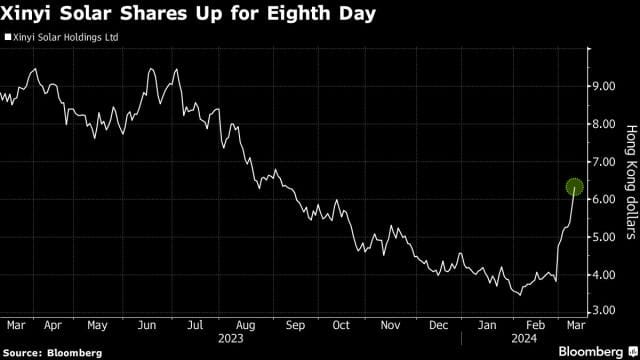
Xinyi Solar Holdings Ltd. and Flat Glass Group Co. both jumped at least 8%
market speculation China will allow a curtailment rate of more than 5% for power generated from renewable projects including solar farms
relaxation is likely given regulators’ recent tone on managing renewable power utilization at a “reasonable level”
raised the full-year estimate for China solar installation by 21%
New all black 450 W 22.5% Trina solar module, March 2024
power output of up to 450 W
power conversion efficiency of up to 22.5%
uses 210 mm diameter wafers and features double-glass design in place of the conventional glass-and-backsheet structure
NEG9R.25 dual-glass module combines n-type i-TOPCon technology
1.6 mm heat-strengthened glass on the front and back while the all-black aesthetic has been achieved by incorporating black cells with thin busbars, along with a black frame and encapsulation material
expected to be available in Australia next quarter, measures 1,762 mm x 1,134 mm x 30 mm and weighs 21 kg
product guarantee of up to 25 years and a performance guarantee of 30 years
1% degradation in the first year and less than 13% over 30 years
New middle distance electric truck
MT50e offers a GVWR of 23,000 lbs
range of up to 180 miles on a single charge (more than enough to cover my Matco guy)
new, “fleet optimized” battery capacity (smaller)

new electric export power system from Odyne that replaces the traditional ICE generators that power utility bodies, mobile disaster relief “command centers,” reefer units, and mobile medical units
built to the same body dimensions as gas and diesel MT chassis, meaning that a fleet’s existing bodies can be used on the MT50e with few or no changes, making it that much easier to integrate them into existing fleets
streamlined, integrated design with no reduction in cargo capacity compared to its diesel counterparts
smaller battery packs with shorter range and the addition of slower, “Level 2” home charging
easier to charge these trucks at home
“Which is a reasonably common use case, or so I’ve heard.”
Resi solar down 15% to 20%+ in 2024
our call that US resi solar is down 15% in 2024
The first third of the year continues to be challenged, and our contact is expecting the market to stabilize starting in May/June with potential for acceleration and growth in Q4
sees stabilization in TX, FL, the Northeast, but the Midwest is quieter than expected. CA likely is worse than expected, i.e. down more than 30-40% in H1’24
If May/June end market activity does not pick up, then our US resi solar down 15% in 2024 is off the table, and we may be closer to down 25-30%
Despite the recent preservation of NEM in the Netherlands (see here), grid congestion in the Netherlands is still an issue and getting permits “is a long and frustrating process.”
country’s grid companies are understaffed and may need 60k technicians to carry out the required upgrades according to a contact
Wichita extends solar ban
Instead of voting on more stringent new regulations covering solar farms, the county commissoners agreed to extend their moratorium
“Today’s actions by the Sedgwick County Board of County Commissioners replicates earlier efforts and essentially ignores the research, community feedback and recommendations of these groups, further delaying the positive economic impacts solar projects will bring to local landowners and communities,”
originally created a six-month ban on energy projects last September to give them time to revise rules for commercial solar farms
India subsidizing 50% of solar powered pump for farmers
subsidy, now standing at an alluring 50%
More than 50 solar power product stalls were set up at the mela
concerted effort to embrace sustainable energy and accelerate the widespread adoption of solar pump sets
launched the Soura Mitra app which will help streamline the applications of farmers who wish to install solar-powered pump sets
Eight hour lithium ion battery
generate 150MW of power and “store up to 1,200MWh”
“eight hour” battery
utilise lithium-ion batteries and occupy 20 acres of land, with 23 used in total for the balance of plant (BOP) components
located within the existing right-of-way land of the Alta 1 Wind Facility project in Kern County, California
Battery package defects in quarter of projects
One quarter of large-scale batteries have built-in fire risks caused by manufacturing defects in components
26 per cent of battery energy storage systems (BESS) have quality problems with their fire detection and suppression systems
faults include fire alarm abort buttons and smoke and temperature sensors not being correctly wired in
18% of units had defects in their thermal management systems due to parts that weren’t installed properly
company audited 52 factories in the US, China, India, Vietnam and South Korea, and found 1300 manufacturing issues in some 30 gigawatt hours (GWh) of lithium-ion projects
quarter of all problems came from cell manufacturing – half come when the battery is installed and tested on site
install issues – balance of plant problems such as liquid coolant leakage due to deformed flange plates, defective valves, and malfunctioning temperature, smoke, gas sensors, audible and visual alarms due to internal mis-wiring; mistakes made during the installation of enclosures; and performance testing which saw the largest number of critical and major incidents
Bouldercombe fire was caused by a problem in the way the 50 MW/100 MWh battery interfaced with the grid
failure has been isolated to the power electronics interface with the AC bus bar in the individual Megapack unit itself and not the broader installation of Megapack units